










This, the April issue of MEA Finance sees us well on our way into Spring, the second season of the year and natures’ version of Q2. As the weather generally warms up (for us in the northern half of the globe) we see the signs of regrowth and renewed or continuing activity, which in some ways mirror the signs of activity and growth in parts of the regional banking, financial and payments markets.
So, in this edition - from page 32, we look upon Islamic Finance, which is seeing growth in its share of the regional banking market, with the increase driven by factors including ESG and by gaining the attention of newer generations, “the key drivers of the Islamic banking sector will be Millennial and Generation Z Muslims, who are expected to account for 75% of Islamic banking revenue within the next ten years”, quotes Christophe Lalandre, Senior Executive Officer at Lombard Odier, Abu Dhabi Branch.

Our cover story this month - starting at page 28, features an interview with Nandan Mer, Chief Executive Officer at Network International the UAE born providers of payments products and services across the Middle East and Africa. Mr. Mer, aware of the opportunities that the UAE has brought them as a business, extolls their key values as a leading payments business, “Network never underestimates a prospective merchant, be it a small business or an institution”.
Once again we treat you to a seat at another of our popular roundtables. This time we partnered with Volante Technologies and leading managers and thinkers from the regional banking and finance sector to debate the ongoing growth in the development of payments in the region - starting on page 18.
A visible spring in the growth of contributors opinions is clear in this issue - from page 54, with thoughts from Virtuzone on the possible impact of the Silicon Valley Bank debacle on start-ups in the region, Saxo Bank offering their views about how COP28 will affect regional sustainability trends and Backbase highlighting their view of the factors behind the growth of Saudi Arabia’s digital banking sector.
Circling back to our payments coverage - on page 52, Onur Ozan, Managing Director/Regional Head – Middle East, North Africa and Turkey at Swift updates us on progress in faster, friction free payments in the region, pointing out that, “It is important for all parties in the cross-border payments ecosystem to evolve together to create seamless payments that meet changing expectations”.
The typical colour, action and diversity of the season continue to be reflected in this issue with looks at regional M&A - at page 14, and coverage of the Debt Capital Markets, where HSBC’s Khaled Darwish expresses, “I am a strong advocate for the view that the Middle East is emerging as an ‘economic powerhouse”, from page 42. There is an interesting look at Land Assets in the USA with Walton International - from page 48, followed by Infosys describing how recomposing is what banks today need to do to remain at the top of their game and maintain relevance to their customers and value to shareholders, in our regular spotlight on Banking Technology - at page 50. Finally, and not forgetting our Market Focus, which this month is on Oman, we look at the major moves made in structural reforms and economic diversity under Sultan Haitham’s Vision 2040. Read about this from page 10.
With our Market News at the front of this issue, once again we hope that April's MEA Finance will provide you with a renewal of your enjoyment for reading about the growth of our region’s banking and financial markets and bring a spring in your step as you work through this month.



Kenneth Mitchen ken.mitchen@mea-finance.com

GROUP COMMERCIAL DIRECTOR Nap Estampador nap.estampador@mea-finance.com Tel : +971 50 100 5488 DIRECTOR Andrew Cover andrew.cover@mea-finance.com
EVENTS AND MARKETING MANAGER Cris Balatbat crissyb@mea-finance.com
Tel: +971 58 594 4818

EVENT AND CONTENT DIRECTOR Natasha Cristi natasha@mea-finance.com

Tel: +971 50 303 4235
SENIOR DESIGNER Florante Magsakay
Tel: +971 52 570 1811 design@mea-finance.com
ADMIN AND FINANCE MANAGER Marilyn Nainque marilyn@mea-finance.com
Tel: +971 58 5025836
WEB ASSISTANT Marie Orayan web@mea-finance.com

FEATURE CONTRIBUTORS: Mushtak Parker, Walter Sebele editorial@mea-finance.com
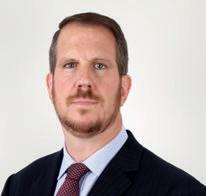
Dubai office: #404, Building B, Al Saaha Offices, Old Town Island Burj Khalifa District PO Box 487177, Dubai, UAE Email: info@mea-finance.com

dynamic, tech-driven economy. We look forward to leveraging this momentum by bringing Sygnum’s trusted digital asset services to Abu Dhabi and the region.”
Sygnum’s local presence in Abu Dhabi enables it to directly access a large and increasingly crypto-active wealth management market. According to new research, the Emirate of Abu Dhabi is a true “falcon economy” possessing the highest economic growth in the MENA region. With 35% of the UAE population already invested in the local USD 25bn crypto market and over 1,400 crypto organisations locally based, Abu Dhabi has the potential to become a future regional and international hub for Web3, metaverse and blockchainbased projects.
Sygnum Bank Middle East has received a Financial Services Permission (FSP) from the Abu Dhabi Global Market (ADGM) Financial Services Regulatory Authority (FSRA), following its in-principle approval in October 2022. Seasoned Middle East Executive, Giulia Finkbeiner-Bertoni, leads Sygnum’s operations across the region and opens the office in the ADGM International Financial Centre.
Sygnum Bank Middle East will offer personal, concierge-style client service, enabling convenient local client access to a portfolio of Swiss-regulated digital
asset banking, asset management, tokenisation and B2B banking services. With regional demand for regulated crypto services on the rise, clients will be drawn from a diverse range of sectors, ranging from existing local crypto foundations and projects to “traditional” institutional investors and qualified HNWI looking for trusted crypto asset exposure through a regulated partner.
Sygnum Bank Middle East’s Senior Executive Officer, Giulia FinkbeinerBertoni, says “The UAE has a proactive investment programme, a progressive crypto regulatory framework and a
Welcoming the FSP announcement, Arvind Ramamurthy, Chief of Markets at ADGM said, “ADGM congratulates Sygnum Bank ME for obtaining their Financial Services Permission from ADGM’s FSRA and welcome them to our rapidly growing business ecosystem. We believe that Sygnum’s regulated finance offering in Abu Dhabi is a significant addition to our community and will contribute to the growth of the region. As the largest regulated jurisdiction for digital assets in the MENA region, ADGM acts as a catalyst with the right tools that enable the growth of such companies within the UAE’s financial sector. With Sygnum’s presence in the region, we are committed to upholding market transparency and integrity that bolsters the economic growth of Abu Dhabi, attracts global companies and aids in making it a digital-first international financial hub for seamless business transactions.”
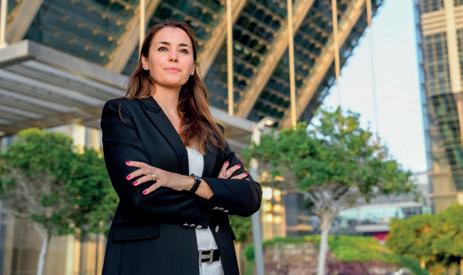



The industry’s loan-to-deposit ratio of 95% is definitely more than desired and reflects some pressure on banks to improve their liquidity through raising deposits if they wish to fetch the benefits of economic growth funded by the government’s spending on key sectors and the roll-out of its giga projects.
With the global banking industry making headlines in the past weeks, the Saudi banking sector published its annual results for 2022. According to KPMG, a leading provider of audit, tax and advisory services, in its annual market update, the consolidated numbers for the ten Tadawul-listed banks reflect a robust performance, particularly indicating an increase in net profit by 28%, reaching SAR 62.71 billion ($16.7 billion). The growth trajectory is expected to continue on account of consistent demand for public and private sector financing and the availability of noninterest-bearing deposits.
The challenges faced by the global banking sector were particularly heightened by shockwaves sent by the failures of Silicon Valley Bank and Signature Bank in the US and the acquisition of Credit Suisse in Europe.
“During 2022 the total assets of Saudi banks grew 11.5% reaching SAR 3,832 billion ($1.02 billion) while deposits are up by 8.34% and closed at SAR
2,296 billion ($611.7 million).. We have seen the added liquidity requirements were fulfilled through Tier 1 capital and sukuk,” commented Ovais Shahab, Head of Financial Services at KPMG in Saudi Arabia.
Overall, the banking industry has continued to capture the benefits of economic expansion, evidenced by an increase in lending and reaching a loanto-deposit ratio of approximately 95.5% at the end of December 2022 and an increase in loan books by 14.44% yearon-year.
The increase in net profit from last year is further marked by a substantial decrease in expected credit loss (ECL) allowances, which declined by 19.25% year-on-year to SAR 9.87 billion as the industry has successfully come out of Covid-19 and better managing portfolio performance across various industry segments.
“Banks are cognisant of anticipated pressures on liquidity and accordingly we have evidenced capitalisation of retained earnings, issuance of Tier I capital and customised solution to cater to future economic needs and shifting market dynamics,” added Shahab.
An upsurge in such Tier I capital issuance has been noted across the banking participants to support the core equity base and fulfil the financial and strategic needs. At present, SAR 28.14 billion ($7.5 billion) has been issued, which is likely to increase further in the near future according to Shahab.
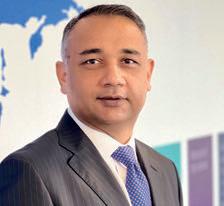
Going forward, risks seem more dynamic and interconnected than ever before; emerging technologies rise as a major disruptor in business and the greatest threat to organisational growth if they are not agile and fast enough to change. KPMG believes that operational excellence will remain a high priority while regulatory changes will only grow over the next few years.
“SAMA has always extended support to the banking industry so that market participants can continue playing a crucial role in the ambitious economic expansion agenda of the Kingdom,” Shahab concluded.
Saudi banking sector indicated increase in net profit by 28%, reaching SAR 62.71 billion ($16.7 billion)

Under Sultan Haitham’s Vision 2040 economic blueprint, the government has made significant strides in implementing structural reforms to diversify the economy and spur sustainable growth
Oman is considered to be among the weakest sovereigns in the GCC region, but the Sultanate is emerging as a reform standout, with fiscal consolidation measures and progress on structural reforms. A rally in oil prices last year is expected to generate fiscal and external surpluses and support to growth.
The country’s improved fiscal performance and lower public debt caught the attention of all three major rating agencies—Fitch Ratings, Moody’s and S&P Global—who could not help but upgrade its ratings as well as their outlooks, citing strong economic growth prospects.
“The outlook could be bolstered by higher-than-expected hydrocarbon
windfalls, accelerated implementation of structural reforms under Vision 2040 and the realisation of investment projects from regional partners,” said the International Monetary Fund (IMF).
Global economies have been grappling with a multitude of shocks—from the geopolitical conflict in Europe, a lingering pandemic, a meteoric rise in inflation and tightening monetary policy—that elevated uncertainties. However, like other Gulf Arab states, a boon for Oman is low inflation as prices of consumer goods are controlled by government subsidies and price caps.
Under Sultan Haitham bin Tariq Al Said’s Vision 2040 economic blueprint, the government has made significant
strides in implementing structural reforms to boost Oman’s non-oil economy, drive diversification and spur long-term sustainable growth.
The efforts include cutting subsidies, restructuring government and state entities, introducing a value-added tax (VAT) and even planning for income tax— which is expected to be the first for a Gulf Arab state. Oman’s wealth fund, which manages funds on behalf of the Sultanate, is developing the country’s targeted economic sectors by implementing large projects in partnership with the private sector.
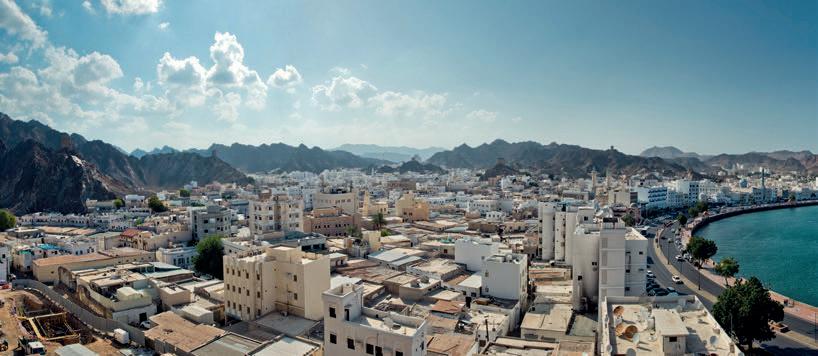
Oman enjoyed a strong finish to 2022 and the Gulf state remains relatively insulated from the global economic downturn, elevated inflation and high-interest rates as the economy is projected to expand by 4.1% in 2023.
With the almighty Brent benchmark ending last year near $80 per barrel after earlier leaping to $100, the finance ministry projected that Oman fetched $28.6 billion (OMR 11 billion) from exporting hydrocarbons and revenues from non-oil activities raked in $8.4 billion (OMR 3.2
billion)—swinging the budget to surplus for the first time in almost a decade.
The country’s public revenues skyrocketed by 34.5% to $39 billion (OMR 14.2 billion) from $28.2 billion (OMR 10.9 billion). Higher oil prices on the back of the war in Ukraine has pushed crude above Oman’s break-even level of $61 a barrel and is expected to accelerate economic growth to a pace not seen in a decade.
Last year, the Sultanate said it would allocate the windfall from oil receipts towards developmental projects and initiatives to support economic growth as well as to reduce its debt. “Oman’s first surpluses since 2013, as oil revenues easily outweigh additional spending,” said Fitch.
Sultan Haitham ratified his country’s 2023 budget with a deficit of $3.38 billion (OMR 1.3 billion) or 3% of GDP. Oman’s budget projected revenues of $30.1 billion (OMR 11.7 billion) up 10% compared to $27 billion (OMR 10.6 billion) and expenditures of $34 billion (OMR 12.9 billion), a 7% increase from the previous year. KPMG said that the 2023 budget represents the first plan of Oman Vision 2040 that aims to achieve financial sustainability while stimulating economic sector diversification.
Oman plans to implement and develop a total of 110 investment projects by end of the year and more projects are expected to come from a raft of deals that were
signed between the Sultanate and its Gulf allies—the UAE and Saudi Arabia last year.
The FY2022 state budget was based on an oil price of $50 a barrel but the government now estimates the average price in 2023 to be $55. Oman, a member of OPEC+, will boost production output by more than 10% in 2023 to 1.175 million barrels per day.
The Sultanate’s credit ranking was upgraded for the first time by Fitch Ratings, S&P Global and Fitch as the windfall from rising oil prices has eased
to prepare the country for a time after oil. Oman has implemented a series of reforms as part of the government’s broader strategy to balance the budget, reduce debt and bolster public finances, including the introduction of VAT, cutting subsidies and restructuring governmentowned entities.
The Gulf state seeks to focus on subsidies, public-sector employment and the provision of safety nets as part of its future fiscal reforms. “While the government intends to broadly continue
financing pressures and reversed nearly a decade of budget deficits.
Fitch said that its upgrade reflects significant improvements in Oman’s fiscal metrics and a lessening of external financing pressures and analysts at S&P Global concurred that the country’s fiscal and external positions are benefiting from government reforms and an increase in oil prices.
The creation of a new position of the crown prince on the first anniversary of Sultan Haitham’s Accession Day reassured Oman’s allies and foreign investors of an open succession plan. Economists expect the devolution of power to allow for quicker decision-making as Oman is set to extend an economic overhaul that has helped to stabilise the Sultanate’s finances.
Since taking power in January 2020, Sultan Haitham has introduced reforms
with its fiscal reform program, we expect it will allocate some of the forecast oil windfalls this year to support economic activity and reduce the impact of past austerity on the population,” said S&P Global.
Oman started levying a delayed 5% VAT in April 2021 following the lead of its GCC neighbors. FY2023 budget estimates that VAT and excise tax revenues will increase by 10% to $1.5 billion (OMR 590 million) compared to the 2022 budget of $1.4 billion (OMR 535 million) while corporate income tax revenues are set to jump by 20% to $1.45 billion (OMR 560 million).
VAT is aimed at ensuring Oman’s financial sustainability after the country accumulated huge amounts of debt over the past few years to compensate for its dwindling oil revenues. Trimming public debt and restructuring public institutions and companies is one of a series of steps taken by the Sultanate to improve fiscal

WHILE THE GOVERNMENT INTENDS TO BROADLY CONTINUE WITH ITS FISCAL REFORM PROGRAM, WE EXPECT IT WILL ALLOCATE SOME OF THE FORECAST OIL WINDFALLS THIS YEAR TO SUPPORT ECONOMIC ACTIVITY AND REDUCE THE IMPACT OF PAST AUSTERITY ON THE POPULATION
– S&P Global
efficiency after sensitive reforms had lagged for years.
Over the past two years, Sultan Haitham merged several state entities, including Oman’s wealth funds and appointed finance and foreign affairs ministers as well as central bank chairman – portfolios that were held by the late Sultan Qaboos.
The Oman Investment Authority (OIA), which manages funds equivalent to 40% of the country’s economy, now manages $41.5 billion (OMR 16 billion) of assets in 40 countries as the wealth fund increases its holdings in real estate, technology and logistics.
Oman divided its wealth fund into two units overseeing local and foreign assets in April. The ‘Generation Portfolio’, which consists of foreign assets and some local assets in various instruments, including
attract private sector investors and many private firms.
OIA and Abu Dhabi’s ADQ announced last September that they have identified investments worth 30 billion dirhams $8 billion (AED 30 billion) in Oman including a $3 billion (OMR 1.16 billion) to link the two Gulf states’ rail network.
The government also established Energy Development Oman (EDO) to monetise the country’s largest oil block. EDO owns a 60% interest in Block 6, which is one of the biggest crude deposits in the GCC region and has a production capacity of 650,000 barrels a day.
Oman, which is expected to break ranks and become the GCC state to introduce an income tax on high earners, has taken measures to enhance sustainable growth while attracting foreign investors and talent.
Oman’s stock exchange joined forces with UAE-based Al Ramz Corporation Investment and Development and Ubhar Capital to formulate capital market opportunities as part of ongoing efforts to attract more listings.
state subsidies on electricity and water to only those groups who need it, rather than subsidising all users.
Oman unveiled plans to expand its visa-fee exemption to more than 100 countries in 2021 to boost its tourism industry. The Gulf state is also considering a new investment residency program as part of its wide-ranging reforms to fix its finances.
Omani banks, like their GCC peers, entered 2023 ‘on solid footing’ despite higher uncertainty. “Benefiting from prudent oversight of the Central Bank of Oman and strong buffers, the banking system has weathered the recent shocks relatively well,” said the IMF.
Meanwhile, pressures on small banks’ profitability, alternative delivery channels and competition from digital banks are expected to increase shareholders’ appetite for consolidation to enhance the resilience of banks’ financial profiles.
public and private markets and real estate portfolios, aims to achieve the greatest returns for future generations.
The other unit, the National Development Portfolio, which has stakes in more than 160 companies and manages local assets, will help support Oman’s general budget through dividend distributions. This second unit looks to
The Sultanate’s efforts come amid continuing demand for new shares in the Middle East despite a worsening backdrop for the global economy. The government raised $244 million (OMR 94 million) from the initial public offering of Abraj Energy in what the country’s largest IPO in more than decade.
Though Omani authorities dismissed reports about a new personal income tax on high-wage earners that will likely be introduced in 2023, the plan is currently under study. The country will also redirect
Sohar International Bank received the central bank’s approval to merge with HSBC Bank Oman in February. Sohar International is also linked with a potential merger with Omani Islamic lender Bank Nizwa. Both proposed mergers are subject to regulatory and shareholder approval.
Oman marked the anniversary of Sultan Haitham bin Tarik’s Accession Day with robust post-pandemic growth driven by the government’s supportive economic measures and higher oil prices. With major improvements in its fiscal performance, the steadfast implementation of a medium-term fiscal plan would bolster economic growth.
THE 2023 BUDGET REPRESENTS THE FIRST PLAN OF OMAN VISION 2040 THAT AIMS TO ACHIEVE FINANCIAL SUSTAINABILITY WHILE STIMULATING ECONOMIC SECTOR DIVERSIFICATION
BENEFITING
PRUDENT OVERSIGHT OF THE CENTRAL BANK OF OMAN AND STRONG BUFFERS, THE BANKING SYSTEM HAS WEATHERED THE RECENT SHOCKS RELATIVELY WELL
– The International Monetary Fund
The new standard in low-value international payments.
swift.com/go

A robust banking sector able to finance new industries is seen as key to boosting the dynamism of the private sector and accelerating economic diversification
Mergers and acquisitions

(M&A) slowed substantially in 2022 as financial institutions faced a mix of economic uncertainty, rising interest rates, heightened regulatory scrutiny and the possibility of a recession. S&P Global said that the influence of rising interest rates on merger math stood as another
catalyst to dealmaking and deal advisers expect that dynamic to continue in 2023. These pressures are more pronounced in the Middle East where small lenders’ wafer-thin margins, competition from digital attackers and alternative delivery channels will likely increase shareholders’ appetite for consolidation to reinforce banks’ financial profiles.
It is worth noting that growth in the Middle East banking assets is linked to regional GDP, which moves largely in tandem with oil prices. A rally in oil prices, which traded mostly above the $90-mark last year, had the effect of pushing the budgets of the region’s oil exporters into the black for the first time in years and the spill over effect is being felt across the banking sector.
Oil-rich Gulf Arab states are witnessing an economic boom fuelled by soaring oil prices in the wake of geopolitical tensions in Europe, giving sovereign wealth funds and banks the firepower they require to hunt for deals amid a weakened global outlook.
Moody’s said that stronger government finances benefit banks’ solvency, funding and liquidity due to
their dominant role as key depositors, borrowers and shareholders in the Middle East’s banking system.
M&A is and will continue to be a driver of transformation in the financial sector as incumbents look for strategic partnerships and consolidation opportunities to boost digital capabilities, counter the disruption from digital attackers and address sustained pressure from regulators.
With the backing from some of the world’s biggest sovereign wealth funds, banks in the Gulf Arab states cannot hide their growing ambitions to dominate the global financial services industry. Earlier this year, First Abu Dhabi Bank (FAB) said that it had considered a bid for Standard Chartered (StanChart) but was no longer doing so.
Though Standard Chartered executives said there was no official communication and FAB reiterated that it was not evaluating currently evaluating an offer, industry experts say a potential bid confirms the Abu Dhabi lender’s takeover appeal, given its wide emergingmarket footprint, improving efficiencies and supportive capital return.
FAB was created via a landmark merger between the National Bank of Abu Dhabi and First Gulf Bank in 2016—a tie-up that sparked a deluge of consolidations in the Middle East’s financial services industry.
Saudi National Bank (SNB) invested as much as $1.5 billion in Credit Suisse last October for a stake of up to 9.9%—making the Saudi bank the top shareholder. Meanwhile, the Qatar Investment Authority is now the second-largest shareholder in the Swiss lender after the wealth fund increased its stake to 6.8% late last year.
Credit Suisse also counts Saudi Arabian conglomerate Olayan Group among its top shareholders. Buoyed by bumper hydrocarbon receipts, investors based in the GCC region increased their shareholdings in European financial institutions in 2022 and could buy further financial services stakes this year.
Speaking with Bloomberg Television on the sidelines of the World Economic Forum in Davos, Standard Chartered Bank CEO Bill Winters said that it was quite logical for Middle Eastern banks to be interested in buying European financial institutions given their relative valuations, though he does not think a deal with FAB is likely.
Oil-rich Gulf Arab states are keen to use their oil windfall to transform the region’s financial sector. A robust banking sector able to finance new industries is seen as key to efforts to boost the dynamism of the private sector and accelerate economic diversification.
The structural characteristics of banks
in the Middle East are a diverse mix of conventional and Islamic entities, as well as being both retail-focused and corporate-aligned in their stance, which from a potential future merger perspective will offer value-added consolidations.
KPMG said that with a growing appetite for M&A’s in the GCC region, the focus should be on making sure that wellexecuted transactions are supported by robust plans. Whether a tie-up or a divesture, drawing up a well-defined plan from the outset is key to increasing buyers’ confidence in targets’ ability to deliver on strategy and synergies.
If the creation of FAB paved the way for a wave of mergers across the Middle East, Emirates NBD’s takeover of Turkey’s Denizbank in 2019 triggered a wave of acquisitions as regional banks are increasingly expanding their operations to sustain growth.
Sohar International Bank received the central bank’s approval to merge with HSBC Bank Oman in February. Sohar International is also linked with a potential merger with Omani Islamic lender Bank Nizwa. Both proposed mergers are subject to regulatory and shareholder approval.
The Middle East’s banking system remains highly fragmented making competition intense and the situation is expected to intensify due to an evolving operating environment as the region is not immune to the global squeeze and high inflation and rising interest rates are being felt.
“Retail banks attain scale by capturing market share, merging with or acquiring other banks and pursuing fastgrowing markets. Increasing revenues is fundamental to this process and strategically vital because it enables banks to compete effectively over the long term,” said McKinsey.
The combination of high inflation and economic uncertainty has created a challenging operating environment for financial institutions to grow their revenue organically forcing banks to
RETAIL BANKS ATTAIN SCALE BY CAPTURING MARKET SHARE, MERGING WITH OR ACQUIRING OTHER BANKS AND PURSUING FAST-GROWING MARKETS. INCREASING REVENUES IS FUNDAMENTAL TO THIS PROCESS AND STRATEGICALLY VITAL BECAUSE IT ENABLES BANKS TO COMPETE EFFECTIVELY OVER THE LONG TERM
– McKinsey
rely on acquisitions to pick up attractive customers and valuable assets.
Banks in the Middle East region are facing the pressure of tighter liquidity and increasing competition amidst a more challenging macroeconomic backdrop and past mergers have demonstrated the merits of tie-ups.
Earlier in January, Bank ABC said that it has completed the merger of its Egyptian business with BLOM Bank Egypt. The deal tripled Bahraini lender’s market share in Egypt to create a bank with total assets of $2.5 billion (EGP 67 billion). Kuwait Finance House completed its acquisition of Bahrain’s Ahli United Bank last October—a rare cross-border tie-up that had been almost four years in the making.
Abu Dhabi Islamic Bank ( ADIB) acquired an additional 2.4% stake in its Egyptian unit, ADIB Egypt, in a deal valued at $6.3 million (EGP 155.32 million) taking its total shareholding to 52.61%.
FAB’s Egyptian unit FABMISR completed integrating banking services with Bank Audi Egypt last November.
“In a rapidly changing business environment, M&As and divestures are levers to rapidly transform a business, gain a technological edge over peers and create value,” said KPMG. Banks in the MENA region have been consolidating to improve economies of scale, reduce operating and funding costs as well as boost profitability and efficiency.
Last year, Jordan’s Capital Bank acquired 100% of Societe Generale Bank Jordan, took over Lebanese Bank Audi’s businesses in Iraq and Jordan and sold a 23.97% stake to Saudi Arabia’s Public Investment Fund for $185 million in a deal that is expected to help the bank expand its operations in Jordan, Saudi Arabia, Iraq and other markets.
Past mergers in the GCC have demonstrated the merits of tie-ups. The scale achieved from these tie-ups is leading to improved liquidity management, enhanced profitability and reduced inefficiencies with better cost-to-income ratios.
The second wave of deal-making could begin when the full impact of the current challenging operating environment becomes visible. Fitch Ratings said that the fragmentation in the Middle East region banking system is greater compared to other emerging markets,
of its $10 billion pledge to help shore up the finances of the North African country. United Bank, Banque du Caire and Arab African International Bank are part of the 32 companies in which Egypt looks to sell government stakes as the Arab world’s most populous nation seeks to bolster its economy after its financial markets suffered heavy foreign investment outflows last year.
Italy’s Intesa Sanpaolo Group is also in advanced talks with Egyptian authorities to acquire the remaining 20% of the Bank of Alexandria (AlexBank) it does not own. AlexBank is one of the country’s main private sector banks with 175 branches and 1.6 million customers and a court ruling on a long-standing legal challenge against the original sale of the lender to Intesa will determine if a takeover can go through.
A surge in domestic consolidation, divestiture of non-core businesses and scope deals are likely to shape the Middle East’s M&A market in the future as financial institutions seek to create larger entities that are financially more robust and efficient.
– Moody’s
with many banks resulting in strong competition and weak pricing power.
Saudi Arabia shelved plans to acquire the United Bank of Egypt in February amid disagreement over the value of the multi-million-dollar transaction. The Gulf state’s wealth fund kicked off talks with the Egyptian government to acquire the state-lender bank last December as part
After years of record-breaking dealmaking in the global financial services sector, conditions changed last year as M&A slowed in response to economic headwinds, a potential downturn and geopolitical uncertainty. While it is still difficult to decipher how the M&A market may evolve in 2023, there are signs of life in the Middle East.
STRONGER GOVERNMENT FINANCES BENEFIT BANKS’ SOLVENCY, FUNDING AND LIQUIDITY DUE TO THEIR DOMINANT ROLE AS KEY DEPOSITORS, BORROWERS AND SHAREHOLDERS IN THE MIDDLE EAST’S BANKING SYSTEM
IN A RAPIDLY CHANGING BUSINESS ENVIRONMENT, M&A’S AND DIVESTURES ARE LEVERS TO RAPIDLY TRANSFORM A BUSINESS, GAIN A TECHNOLOGICAL EDGE OVER PEERS AND CREATE VALUE
– KPMG



Top executives from the regional banking and payments business joined MEA Finance and Volante Technologies as we partnered for another of our special roundtable debates to discuss the modernisation of payments and what this means for the financial sector

Technology is reshaping the economics of how we do business as traditional barriers to change have been eroded in favor of efficient, open and scalable platforms such as the cloud. The modernisation of the payments sector is an important journey that economies around the world are either embarking on or experiencing right now.
The UAE is about to roll out a real-time payment platform, which industry experts say will benefit people, businesses and the financial service sector. The country’s payments landscape has evolved dramatically over the years, driven by the technological innovations in the financial services sector industry that are expected to continue driving disruptive business models in the payments space.
A core advantage of instant payments is that transactions use the ISO 20022 messaging format, a new format that provides richer and high-quality data using more fields, better structure and improved flexibility to adapt to new business processes.
ISO 20022 became a mandatory standard in 2019, with an initial cutover from message type by March 2023 and a transition to native ISO 20022 messaging by the end of 2025.
EY said the migration to ISO 20022 data standards is accelerating the push toward greater digitisation in a global economy while supporting trends around interoperability, data and analytics. The move will ultimately lead to a better understanding of customers and how to service them in a rapidly evolving payments industry.
On the 22nd of February, 2023, MEA Finance, in partnership with Volante Technologies hosted an
exclusive roundtable themed Payments Modernisation: Keeping up and Forging Ahead in a Digital World in Dubai, the UAE.
The roundtable, which was attended by senior representatives from across the UAE’s financial service sector, shared insights on the trends that are emerging in the country’s payments ecosystem while highlighting the opportunities and challenges that the industry will face in the coming years.
Volante, a US-based cloud payments and financial messaging solutions provider works with more than 100 banks, financial institutions, market infrastructures, clearinghouses, and corporate treasuries to accelerate their digital transformation. The company counts Citibank, Qatar Islamic Bank UK, BNY Mellon, Bank Leumi UK and FIMBank among its customers.
McKinsey forecasted that non-cash payments in the UAE will account for 73% of transaction volume this year. Payments are integral to customers’ purchase experience and the bottom line of many financial institutions.
Globally, the payments industry is witnessing an increased level of disruption from non-banking players who specialise in value-added services in the payment ecosystem. For incumbents, outsourcing has become an extremely popular business strategy in this highly competitive world—allowing banks to outsource both core and noncore functions such as transaction management and payments processing.
Payments modernisation is an ongoing process and one that will continue to evolve in line with technology and changing customer demands. The payments ecosystem stands at the edge of significant returns as the pace of fintech disruption moves at a relentless speed.
Ahmed Marouf, Vice President - MENA Regional Head at Volante, stressed that payment modernisation is a critical and core point whenever it comes to the digital transformation of financial institutions.
Technological innovation and a shift in customer behavior and expectations have fueled this disruption, shattering the status quo and opening the window for new players that are challenging incumbent banks. Drawing from her 15-year industrial experience in payments, Rachel Hunt, the VP of Strategy & Growth at Volante, said the magnitude of transformation that is currently underway in the payments space incredible, as the industry
from because what is on the mind of the majority of bank CEOs is value creation,” added Hunt.
She said it is nice when financial institutions introduce new payment methods but what is the value attached to them? How will it transform a financial institution’s business? How will a financial business attach new value-added services to real-time payments? —these are the sort of questions that the industry has been juggling.
– Rachel Hunthas changed drastically over the past 10 years more than it has in the previous 50.
“The magnitude of change in the payments sector brings its problems and challenges. The UAE and the entire Middle East region is at the crossroad where we are still talking about the adoption of digital cards,” said Hunt.
The payments chessboard is being rearranged and understanding these market innovations and acting is critical for financial institutions seeking to grow and prevent disruption. Hunt said UAE payments are nearly leapfrogging a whole series of payments innovation and going straight into digital wallets, digital transformation and real-time instant payments.
“Real-time payments are not just another method of payment but a new way of doing business and strategically establishing where value is going to come
Today’s customer demands more efficient, automated and robust payment capabilities, which is forcing traditional banks to make tough choices on prioritisation initiatives to meet these demands. From a consumer perspective, Vishal Tikyani, the Executive Director, Head of Cash Products, Transaction Banking at Standard Chartered Bank said payment modernisation is targeted toward real-time.
The goal is to make payments less costly while providing full information to the consumer about the end-to-end charges. Customer experience is at the heart of payment modernisation as all companies look for ways to make transacting for their products and services more seamless.
Shiba Nair, Senior Platform Development and Customer Experience at the National Bank of Fujairah said quality management is quite important
REAL-TIME PAYMENTS ARE NOT JUST ANOTHER METHOD OF PAYMENT BUT A NEW WAY OF DOING BUSINESS AND STRATEGICALLY ESTABLISHING WHERE VALUE IS GOING TO COME FROM BECAUSE WHAT IS ON THE MIND OF THE MAJORITY OF BANK CEOS IS VALUE CREATION
for banking customers and they would want to embrace the benefits that come with payments modernisation.
“Customer expectations are evolving and so is the technology. The top priority for banks would be looking into the technology where they can expand to have a technology which is adaptable to the latest technologies that are being introduced,” said Nair.
key investment area over the next one to two years. The industry has evolved dramatically over the years, driven by the advancements in financial technologies that are expected to continue driving disruptive business models in the payments space.
The payments industry is rapidly transforming, driven by new innovative technologies, evolving customer
The increased adoption of payments modernisation worldwide, including realtime payments and straight-through processes and platforms are clear opportunities for all banking segments as companies seek to build a better customer experience.
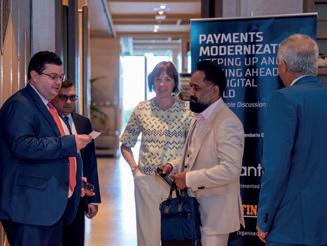
Sanjay Rakesh, Head of Corporate Banking and Shared Services Operations at Zand, said customer experience,
Meanwhile, from a corporate perspective, real-time payments are aimed at solving the pain points problems that businesses face in moving money across borders. IPP makes cross-border payments seamless and instantaneous with all the information that is required from a compliance perspective as well as data analytics, which in the current scheme is a bit of a challenge for businesses.
“The banking sector realised that improving customer experience cannot be done without having equal participation from all the stakeholders within the financial services sector,” Sashi Mundhra, the Head of Solution Consulting – MEA at Volante said, adding that banks are now taking all the stakeholders along when implementing new changes to services and products.
Mundhra noted that most banks in the UAE and the Middle East region expect payment modernisation to be a
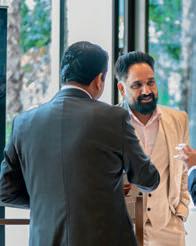

needs and expectations, the shift in the regulatory environment and the adoption of ISO 20022. “The payments industry has come to the forefront because of multiple changes which are happening in the financial service market. It is one critical aspect that cuts across the customer life cycle, the value chain and the stakeholders within the banking,” said Mundhra.
innovative technologies and regulatory changes are the key drivers behind payments modernisation.
Today, we have different channels of payments, different spaces and delivering an omnichannel experience is the priority of every bank.
From a segmentation perspective, Sreedevi Mani, VP of Payments at Emirates NBD said that for a payments transaction
THE SUCCESS OF THE INSTANT PAYMENT IS NOT BY ONE BANK OR A BIGGER BANK, IT IS ABOUT THE COMMUNITY. AS A COMMUNITY, ARE ALL THE FINANCIAL INSTITUTIONS MATURE ENOUGH, ARE WE READY TO ADOPT THE LATEST CUTTING-EDGE TECHNOLOGIES?
– Sreedevi Mani
to be completed within 10 seconds, the underlying technology must be reliant, scalable and safe. She said payment modernisation is determined by the appetite and the maturity of a financial institution or how an entity can integrate the IPP platform within its technology landscape.
Muhannad Tamemi, a Senior OMI Expert at SWIFT, asked Mani how financial institutions check for regulatory
a country, market or jurisdiction. “The success of the instant payment is not by one bank or a bigger bank, it is about the community. As a community, are all the financial institutions mature enough, are we ready to adopt the latest cutting-edge technologies?” she asked.
Payments as a service (PaaS) operating models, next-gen cryptocurrencies, buynow-pay-later innovations and ubiquitous
of banks would still be modernising the payment systems back offices and investing in the cloud.
“There is a bit of a catch-up game to do, the regulator is setting the agenda and the banks and the entire financial services community to catch up with the regulators’ demands,” said Garg.
The changes in the payments industry are not going to slow down anytime soon.
compliance in real-time instant payments processing while noting that in Egypt, Jordan and Saudi Arabia payments can be settled in less than 15 seconds.
Mani emphasised that the efficiency associated with payments settlement depends on the maturity of the technology that is being used in
real-time payments are enabling money to move in new ways, sending shockwaves through traditional payment systems.
Huny Garg, Managing Director and Country Head - KSA & Bahrain at SWIFT weighed in saying in terms of priorities, if it was up to financial institutions to choose what to give importance to, the majority
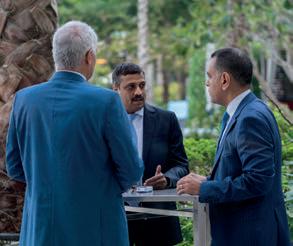
Anand Sampath, Executive Director, Head of Global Payables & Receivables at First Abu Dhabi Bank (FAB) said that there is a huge opportunity for the payment domain with the industry set to grow as much as 8% in the next 7 to 8 years.
“The opportunity for financial institutions is in expanding the payments business and to be part of the modernisation journey to ensure that customers and clients experience a seamless payment journey,” Sampath said adding that towards this goal, several financial regulators in the GCC are implementing initiatives such as open banking in a bid to bring about this paradigm shift to the whole payment industry.
Talat Qureshi, Vice President of Commercial/Payments Solutions at Mastercard said technology has expanded exponentially and banks can leverage the data that comes with this expansion to deliver value-added service to their customers.


THE UAE CENTRAL BANK CREATED SOMETHING FROM SCRATCH, COMPLETELY NEW, TO PROVIDE NOT JUST INSTANT PAYMENT BUT A FULL SET OF OTHER SERVICES FOR THE ENTIRE ECOSYSTEM FOR BANKS AND CUSTOMERS. THERE IS A MOBILE APP AVAILABLE FOR THE CUSTOMERS AND REQUEST TO PAY FOR THE MERCHANTS.
– Enrico Faccin
The payments space continuously reinvests itself to meet the ever-changing expectations and a confluence of geopolitical and economic resets. It is also supporting the growth of digital economies and fueling innovation—all while functioning as a stable backbone for our economies.
Globally, different countries are taking different roads when it comes to payments modernisation but ultimately they are looking for a similar outcome – an open, inclusive and innovative payments space that supports a growing range of new value-added services.
Payment modernisation is an important journey that economies around the world are either embarking on or experiencing right now – the UAE is no exception. “The Central Bank of the UAE (CBUAE) did not decide to introduce a National Instant Payment Platform (IPP) or National Payment Systems Strategy (NPSS) out of blue, but they saw the benefits that the other regions have gained by implementing it and hence
they have come up with the initiative,” said Nair.
From a central bank perspective, it is a call to action to improve clearing and settlement mechanisms, the types and availability of payment instruments available, legal and regulatory frameworks and market arrangements.
Sameer Nemazie, Director of Cash Products MENA at Standard Chartered Bank said payment modernisation in the UAE and the entire GCC region goes beyond the payments industry,

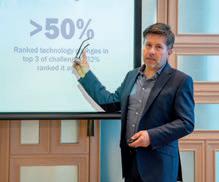

but it is an integral part of the region’s transformation strategy that seeks to eliminate cash payments in favor of realtime instant payments.
Despite the UAE’s digitally savvy population—with a smartphone penetration rate projected at 80% to 90%—a sizable proportion of payments activity in the Gulf state is cash-based but the market continues to shift toward modern, digital payment methods.
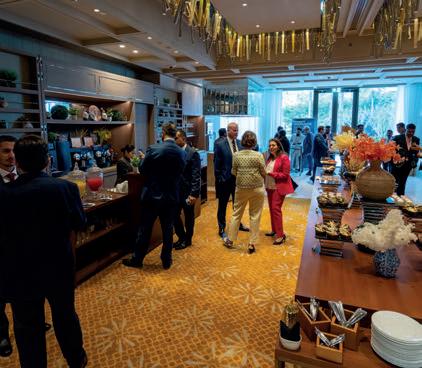
The UAE commenced its payments modernisation in 2020 and began

TO TRANSFORM THEIR CROSS-BORDER PAYMENTS BUSINESS FROM A VERY CUSTOMER- CENTRIC PERSPECTIVE. IT IS A MUCH RICHER STRUCTURED MESSAGING FORMAT AND CAN CARRY MAYBE 100 TIMES MORE DATA COMPARED TO WHAT MT COULD DO IN THE PAST
– Huny Garg
the implementation of its NPSS a year later. The strategy is designed to make payment systems universally interoperable and foster the transition to a cashless society built around realtime instant payments.

Dennis Mathew, Senior Payments Transformation at ADCB said that the implementation of NPSS by central banks will introduce a cashless society while bringing in unbanked customers onto the banking platform allowing them to use real-time instant payment platforms to conduct transactions they cannot perform using today’s payments infrastructure.

Mathew highlighted that when it comes to NPSS, central banks need to create a seamless ecosystem and see how they can bring in more inclusion from the customers while ensuring that various proxy services and value-added services that come to the ecosystem can be leveraged to deliver enhanced experiences to the different segment of customers.
Mohammed Wassim Khayata, CEO of Al Maryah Bank, added that today,


two types of systems are being used to conduct domestic transfer domestically— the IPP and the FTS—which come with their limitations in terms of how much one can transfer and the time it takes to complete a transaction. Hence, the NPSS will remove any friction and make domestic transfers more seamless.
The CBUAE appointed Accenture, Nexi Group’s SIA and G42 Group to build and operate the country’s IPP over the next five years. The platform is laying the groundwork for the transformation of the UAE’s financial services ecosystem and marked the beginning of the next generation of payment services in the region.
Enrico Faccin, Transformation Excellence Senior Manager at Accenture, said when the CBUAE was piloting its national strategy it did not start with a tactical transformation initiative but instead the apex lender started with the “strategy.”

The UAE central bank is setting up a company, it is hiring leadership from all around the world and seeks to be one of the top five central banks in the world.
Faccin said CBUAE will go live with its IPP in the next few months, which is not just a transformation because the central bank already has similar instant platforms.
“The UAE central bank created something from scratch, completely new, to provide not just instant payment but a full set of other services for the entire ecosystem, for banks and the customers. There is a mobile app available for the customers and request to pay for the merchants,” he said.
The IPP is being implemented in a phased approach and will launch with a pilot group of licensed financial institutions. National banks in the Gulf states are connecting to the real-time payments scheme and the platform will enable instant transfers between bank accounts 24/7/365.
The UAE’s IPP will include new services, it is a strategy and it is an evolving road map, added Faccin. The implementation of the instant payment scheme in the UAE is expected to accelerate banks’ adoption of ISO 20022.
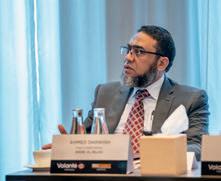


CBUAE has been actively promoting the modernisation of the country’s payments infrastructure for several years and the apex bank is accelerating the process by implementing a domestic real-time payments scheme.
Hrishikesh Chandrashekhar Wadwekar, Assistant Vice President – Payments at Mashreq Bank, said the introduction of NPSS will further
The central bank partnered with G42 Cloud and R3 in March to mark the implementation of its Central Bank Digital Currency (CBDC) strategy—one of the nine initiatives of its Financial Infrastructure Transformation (FIT) programme.
“The whole payment is moving towards a decentralised setup that is core to CBDC. FAB participated in the ‘mBridge’ Project and we were able to send money
of Technology Service Delivery at Commercial Bank of Dubai, said the priority is to have the backbone or the frictionless technology stack in place, then on top banks can add or deploy new services and products as well as the customer or banking experience that an institution seeks to bring to the market.
“There will be something that is coming with the infrastructure in the UAE NPSS but
accelerate digital transformation in the UAE financial service industry.
“From a technology modernisation perspective, most banks are sitting on legacy hardware and infrastructures. The NPSS is pushing financial institutions towards microservice architecture and APIs that will make it possible for banks to deliver a superior customer experience,” said Wadwekar.
Through the NPSS, Wadwekar said the central bank will mobilise banks to upgrade their infrastructures and move to new advanced systems because it is an initiative that is being introduced by the regulator.
Abhinav Khandka, Senior Project Head at Emirates Investment Bank, concurred that the NPSS is a catalyst that is driving payments modernisation and the initiative is something that banks have to “spend energy, time and money on”. He added that the national payments initiative is a standard framework for banks to modernise altogether that requires all financial institutions to work, though it was not on the priority list.
in real-time across four jurisdictions— which is a roaring success,” Sampath said adding that payments modernisation will take away the friction associated with today’s fragmented payment setup.

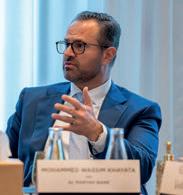
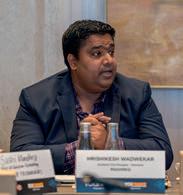
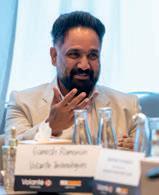
He noted that from an opportunity perspective, CBDC has real use cases when it comes to payment modernisation because it removes the friction and uncertainties associated with foreign exchange corridors and liquidity.
Sasidharan Narayanan, Head
banks need to think about the additional products and services that they will be able to deploy on top of it,” said Narayanan.
Following the success of several CBDC initiatives including ‘Project Aber’ with the Saudi Central Bank (SAMA) in 2020 and the cross-border CBDC pilot under the ‘mBridge’ Project with central banks from Hong Kong, Thailand, China and the Bank for International Settlements in 2022, the UAE central bank is going a step further with the implementation of its
WHETHER WE ARE A BANK FOR RETAIL CUSTOMERS OR OUR CORPORATE CLIENTS, OR WHETHER WE ARE A BANK THAT FACILITATES PAYMENTS FOR FINTECH COMPANIES, I THINK THE FINANCIAL SERVICE SECTOR IS GOING TO WITNESS AN INCREASE IN THE NUMBER OF PLAYERS JOINING THE PAYMENTS ECOSYSTEM.
– Sameer Nemazie
The ISO 20022 standard has already become the reality in several markets. Though the migration to ISO 20022 has been long and not without its challenges, what matters for the global financial community is not the journey but the destination.
Cyril Finan, Vice President of Institutional Cash & Trade at Deutsche
types (MT) and ISO 20022 messages will be supported.
“ISO 20022 allows banks to transform their cross-border payments business from a very customer-centric perspective. It is a much richer structured messaging format and can carry maybe 100 times more data compared to what MT could do in the past,” said Garg.

The adoption of ISO 20022, a globally
as well as business teams, are still not very familiar with it,” he said.
ISO 20022 is emerging as a common language and model for financial messages across the world. SWIFT projected that 80% of global, high-value payments by volume will be processed through this standardised messaging system as major currencies are adopting it.
Bank, said that when discussing ISO 20022 and payment modernisation in general, its more about addressing the technological share and the changes that will come with the transformation, but not so much about the opportunities and where we will go from there.
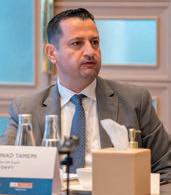
SWIFT said the migration to ISO 20022 for cross-border payments and reporting (CBPR+) officially began in March after years of intense preparation by the global financial industry, marking the start of a coexistence period until November 2025 when both message

developed methodology for transmitting data that provides a consistent messaging standard for payments, by financial institutions is expected to bolster the acceleration of cross-border, cross-currency instant and business-tobusiness payments in the next five years.
However, Garg said one very important aspect that is missing in conversations with banks is the lack of knowledge of the migration to ISO 20022 between the back, middle and front offices. “The conversation on ISO 20022 is still very IT and back-office focused and the product,

“ISO 20022 helps financial institutions with the interconnectivity between crossborder payments and local domestic payments,” Tamemi said while noting that this can be achieved by connecting instant payments with local domestic and cross borders payments. The conversion to ISO 20022 will solve the interoperability between the two standards or two payment rails—the domestic and the cross-border.
Ahmed Darwish, Head of Digital Delivery at Bank Al Bilad said he expects open banking to solve interoperability. Darwish said the idea of open banking at the global level will likely solve interoperability in one way or another and it is an initiative that is expected to be introduced in the future with backing from intergovernmental organisations such as the UN and global regulators like the Basel Committee on Banking Supervision.
He reiterated that like payments digitalisation in general, migration to ISO 20022 is not only about modernisation but that is exactly what is happening in most of the banks in the GCC region.

The rich and structured data enabled by ISO 20022 is an essential element of the next generation of payments. It is the foundation for financial institutions to work smarter and faster, leading to greater operational efficiency, improved data analytics and compliance, new opportunities for innovation and enhanced customer experiences that promise to transform the payments landscape.
Dome Scaffidi, VP, Global Lead Payments Innovation Practice at Volante Technologies said ISO 20022 is coming into force to create other valueadded services. Scaffidi said financial regulators in Europe said real-time payments will become mandatory with effect from November and they need to be free or cheaper than the normal credit transfer. In cases like this financial institutions and fintech firms should look for ways to create new revenue streams, he added.
Though the shift to ISO 20022 will lead to more efficient payment processing, banks must make upfront investments, determine their migration priorities and confront operational impacts.
The structure of better-quality data allows banks to address a plethora of challenges that they face today through increased automation, faster processing, more effective reconciliations, improved mitigation of financial crime risk and better insights into the purpose and context of payments.
The payments industry has grown rapidly
in emerging markets over the past years, as the pandemic accelerated shifts to digital payments and e-commerce. BCG said the notion of paying for goods or services with cash or a physical check is becoming nearly as quaint as the CD player or the large desktop computer.
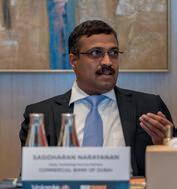
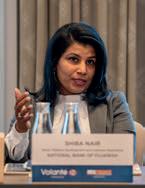
As many companies pivot to the ecosystem and ‘platform of platforms’ models by bringing the different as-aservice models together, payments have become the essential connective tissue. Payments-as-a-service (PaaS) and banking-as-a-service (BaaS) models are increasing in demand—especially as businesses look to offer financial services solutions to their clients to bolster their loyalty.
“Whether we are a bank for retail customers or our corporate clients or whether we are a bank that facilitates payments for fintech companies, I think
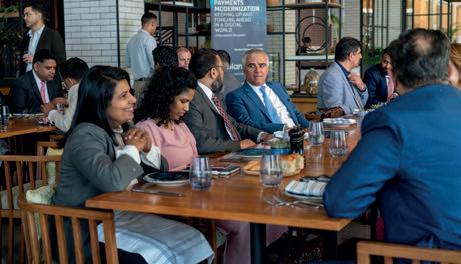

the financial service sector is going to witness an increase in the number of players joining the payments ecosystem,” said Nemazie.

PaaS players operate cutting-edge cloud-based platforms to provide specialised services, such as card issuing, payments clearing, crossborder payments, disbursements and e-commerce gateways. The payments model is creating new revenue streams for many industries while changing the way companies engage with clients.
Volante Technologies’ Marouf said that as much as 80% of the company’s new clients in markets such as the US are PaaS companies. “With the rate of cloud adoption in the UAE and the mandate of CBUAE’s nine initiatives under the FIT program do you expect to see a surge in PaaS players,” Marouf asked the participants at the roundtable.

Terrence Roger Rodricks, Vice President of Payments Ecosystem & Strategic Partnerships at Mashreq Bank said PaaS is making payments seamless for the customers and from a banking standpoint it is a new revenue stream that “we are all going to leverage while assessing how we can partner more with fintechs”.
Zameer Ajaz Punjabi, Vice President of Payments & Remittance at Mashreq, weighed in on PaaS saying providing the product or service depends on the size of the bank and its capabilities because it comes with both pros and cons. “It needs a strategic evaluation on a case-to-case basis about other factors which would involve the risk, which could include weighing the strength of an ecosystem partner and how the service would appeal to the customers,” Punjabi added.
Traditional banks wishing to offer these services can integrate these platforms via APIs, which allow the institutions to link these products into their core banking platforms, in effect building cloud-based payment services.
The disruption of the traditional payments industry has been rapid and impactful. The payments ecosystem is getting more crowded as new technology players enter the market seeking to fill the customer experience
gaps left behind by larger institutions such the traditional banks. Fintechs are leveraging their technological capabilities and customer-centricity to expand into payments.
In attendance at the roundtable were:
• Enrico Faccin, Transformation Excellence Head, Accenture
• Dennis Mathew, Senior Payments Transformation, ADCB
• Mohammed Wassim Khayata, CEO, Al Maryah Bank
• Ahmed Dar wish, Head of Digital Delivery, Bank Al Bilad
• Sasidhar an Narayanan, Head, Technology Service Delivery, Commercial Bank of Dubai
• Cyril Finan, Vice PresidentInstitutional Cash & Trade, Deutsche Bank
• Abhinav Khandka, Senior Project Head, Emirates Investment Bank
• Sr eedevi Mani, VP Payments Platform, ENBD
• Anand Sampath, Executive Director, Cash Product Management Global Transaction Banking, First Abu Dhabi Bank
• Zameer Ajaz Punjabi, Vice President, Payments & Remittance, Mashreq
• Terr ence Roger Rodricks, Vice President - Payments Ecosystem & Strategic Partnerships, Mashreq
• Hrishik
Wadwekar, Assistant Vice President – Payments, Mashreq
• Talat Qureshi, Vice President Commercial/Payments Solutions, Mastercard
• Shiba Nair, Senior Platform Development and Customer Experience, National Bank of Fujairah
• Amol Bahuguna, S VP, Head of Corporate Technology and Change Management Section Riyad Bank
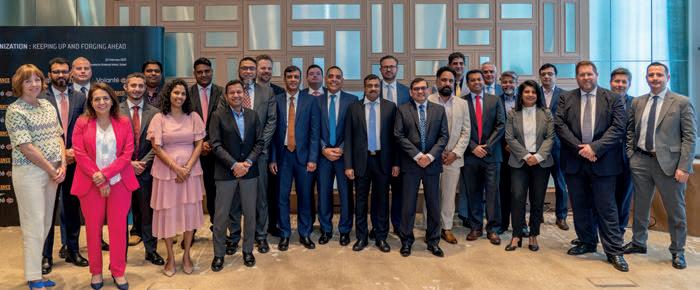
• Vishal Tikyani, Executive Director, Head of Cash Products, Transaction Banking, Standard Chartered Bank
• Sameer Nemazie, Director, Cash Products MENA, Standard Chartered Bank
• Huny Garg, Managing Director & Country Head - KSA & Bahrain, SWIFT
• Muhannad Tamemi, Senior OMI Expert, SWIFT
• Sanjay Rakesh, Head- Corporate Banking Operations, Zand
• Ahmed Marouf, VP & MENA Regional Head, Volante
• Rachel Hunt, VP & Head of Strategy & Growth, Volante
• Sashi Mundhra, Head of Solution Consulting MENA, Volante
• Dome Scaffidi, VP, Global Lead Payments Innovation Practice, Volante.
Nandan Mer Group Chief Executive Officer at Network International talks in detail with MEA Finance about their background and their values, while also explaining how they stay at the lead of the regional payments market during these fast-developing times
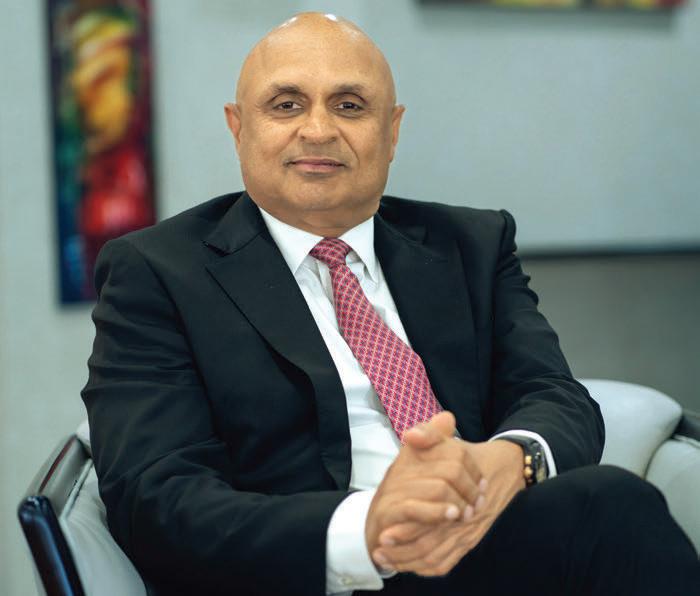
Network is a leading enabler of digital commerce in MEA, what is unique about Network that positions you as such?
Network International is a unique business model to ease digital payments, whether business or consumer related. We digitally connect buyers and sellers, and transport electronic money and data safely from point A to point B. Our uniqueness is that:
We are born in the UAE, a land of innovation and ease of business Network was born in this land of opportunities. The economic and operating business environment in the UAE is world-leading, giving companies and individuals the opportunity to create highly competitive business models historically attributed to a selective few industry giants. The UAE compares favorably to the most mature markets in payments and statistics show that it is no different than other markets that historically were known for their sophistication in the methods of payments. The UAE has a banked rate of over 85%, a highly educated population, strong telco infrastructure, a sophisticated regulatory landscape and excellent government policy, all contributing to creating a very enabling business environment. We have the right environment to succeed.
First mover advantage
Network were amongst the first to introduce the ‘Outsourcing’ of payment capabilities to the region 29 years ago. We started our journey serving ENBD and grew to serving multiple

financial institutions. We build, operate and maintain the most sophisticated payments infrastructure and ecosystem for a large base of merchants and institutions, offering them the ability to also focus on their end customers experience and business ambitions. This resonated early with established banks
Our team is our key success factor! This industry is very specific and specialised and requires a unique stock of knowledge. Since our inception we have been progressively attracting and cultivating talent across all the disciplines relevant to payments. We are proud that
and new Fintechs, initially in the UAE then in other markets in the MEA region. This granted us a first mover advantage in demystifying payments, originally perceived as a complex field and gained us the trust of clients and partners. We currently serve over 150,000 merchants and over 200 financial institutions and fintech customers across 50 countries in the Middle East and Africa.
As we all say, the sky is the limit! Network’s journey reflects a set of strategic choices made at the right time, in the right places. They range from organic growth initiatives, acquisitions, new markets’ penetration, to new products and services. None of this could have been possible without our continuous investments in our human capital, technology platforms and data and cyber-security . Our financial stability and the continuous trust of our clients have enabled us to grow at a high double- digit rate each year. Our focus has never shifted from what we are great at: enabling digital payments in MEA.
Network has become a school of sorts for developing and imparting industry expertise. We often come across many former employees who are thankful for their time at Network and who have since become key talents in their respective organisations. Network invests heavily in human capital through strong learning and development programs, contributing not only to Network’s benefit but to the entire payment community. It is very fulfilling to produce and hone talents who then apply their expertise to the UAE and other markets.
Today, our diverse workforce of more than 1,900 talented employees, represent over 60 different nationalities who help sustain us as the MEA payments champion, driving our purpose of helping businesses and economies prosper by simplifying commerce and payments.
Throughout our journey we established strong partnerships with key industry players and technology experts. These evolved to become an integral part of our assets, allowing us to always be at the forefront of payment trends, and hence offer cutting edge solutions for our esteemed clientele. We continuously search for strong partners to strengthen our offerings a. Our partners contribute to the comprehensive range of services that enabled us to proudly be the only
pan-regional provider of digital payment solutions with a presence across the entire payments value chain.
We never say no to business – we serve big and small, established mature financial institutions or merchants and Fintechs and business startups. We operate as a B2B business with the spirit of a B2B2C. We take up challenges with different levels of complexities, only to prove each time that every client matters, and if a digital payment is involved, we are the partner of choice. When we first heard about e-commerce, we were the first to provide solutions, way back when. When we heard about digital cards, we were the first to provide solutions. And the list of innovations goes on. Our solutions cater to all sizes of business - small, medium and large. Our willingness and ability to listen to our clients and respond positively to their demands is at the core of our being.
Our early investment in technology enabled us in our move to become the first payment provider in the UAE, then in GCC and then across n Middle East and Africa. We did not stop there; we invest over 50 million US dollars annually in technology and infrastructure development. Our customers tell us that we offer comprehensive digital payments capabilities, are innovative, agile and provide highly resilient and secure technology infrastructure.

The payment industry is highly regulated. Central banks, payment schemes, business needs all contribute to framing the way we should do business, and the smallest non-compliance can cause huge reputational and/or financial damage. It can in fact shut a business, and we have seen numerous examples recently where lack of diligence and care about compliance and regulations caused
sudden collapses. At Network, our dedicated teams of experts in the field of compliance are the custodians of our reputation and that of our clients and their end users, protecting the information and money of those who trust our clients and trust us. As our industry matures, regulators in all countries are issuing an ever-growing list of stronger rules and regulations to ensure the safe movement of data and money. Digital identities will soon become the new identity, robotics, AI and the Metaverse are all quickly replacing our conventional ways of operating. Such a huge transformation cannot happen unless the right regulatory frameworks are in place. Governments and key industry players are forced to embrace the trends and quickly create and adapt. And by default, players like us must continuously monitor and comply with those changes, always guaranteeing healthy business. Network operates in 50 different countries and hence we fulfill the regulatory requirements and respond to the specifics and dynamics of each of those markets.
Our industry is very sensitive as it revolves around the movement of money and data, hence we have a zero tolerance for financial risk and/or service disruption.
Network has emerged as a prominent payment provider across the Middle East and Africa. Network has never diverted its focus from the MEA region and has no current plans to explore other regions. The understanding of the local and regional consumer preferences, cultural differences, payment trends and regulatory requirements enables us to offer our best to our clients and stakeholders. We have always recognised the huge potential for development in the MEA region. We were among the first to have entered boldly into the historically challenging payments markets with the purpose of giving them access to the latest payment products and services. We are in MEA to help businesses and economies prosper by simplifying commerce and payment. This has resonated strongly among merchants, financial institutions and more recently Fintechs, positioning us as a partner of choice.
Our dedication to innovatively enabling digital commerce anytime, anywhere across the markets we serve has translated to enduring success for our organisation; we are proudly from, and for, the MEA region.
I would say that our relationships with our clients have thrived due to the high level of mutual trust. Trust is earned and not given, and, on this basis, we have developed our business.

To be able to state confidently that your business is in safe hands, a lot of elements come together - from the safety of the end user credentials to the money in transit, to the credibility of our services and the availability of our resources, to name just few. Network’s reputation is based on solid proven relationships, many of which lasted for more than two decades. Trusting us with processing billions of dollars every year is a clear sign of trust, migrating business to us on several occasions is another sign of trust. Professionalism and business integrity and a high level of ethics make Network a trusted partner that you can reach out to in any situation, who is always ready and pleased to serve. No business is perfect, we learn from mistakes. We continuously seek our stakeholders’ opinions on the status of our relationships and adjust our approach to serving them based on their feedback.
Indeed, this industry is becoming more and more competitive by the day. The emergence of specialised players targeting fragments of the payment chain, or those offering small scale solutions, are slowly establishing themselves around the region. We also witness a few replicating our model on a smaller scale. All of these are yet to build solid foundations before aiming at becoming proven and experienced players capable of bringing concrete, tangible value to the payment ecosystem. However, for those competitors that also operate on a large scale and have a history in the field and solid legacy, we are continuously creating differentiation factors and competitive advantages enabling us to maintain our pole position in the industry.
We constantly invest in talent, technology and capabilities to maintain our market edge. Network is a business in constant transformation.
Our meticulous attention to detail in ensuring compliance with industry and regulatory standards as well as providing secure and reliable service delivery also keeps us ahead of the competition.
What are your growth plans for the business as the decade progresses toward 2030?
Our actions and growth plans always revolve around our clients. We will always aim to be the fastest growing and most innovative customer-centric
payments company in the MEA region. Our success will rely significantly on our refreshed growth strategy, which aims to generate value for all our stakeholders. This strategy focuses on two themes: ‘Accelerate’ – serve more customers, and ‘Innovate’ – serve customers better. Our growth strategy focuses on penetrating new markets, serving the existing markets with new products, enhanced services and availability, exploring new business synergies through M&A’s as fit.
What will the implementation of ISO20022 mean to Network International and how do you operate?
ISO 20022 is yet another revolution in the way financial institutions communicate. The introduction of this transformational protocol will add to the efficiencies of the payment system and reduce cost of operations while extending the benefits through the rich data to offer additional value- added services and lower risk exposure. Network is a strong believer in interoperability, the harmonisation and the standardisation of the core processing flows and methods, and we are already planning on investing in the necessary technological uplift, and the relevant resources to quickly migrate and be part of the winning club! This will complement and support Network’s efforts to help financial institutions improve their operational efficiency and customer experiences, as well as enable new innovative services.
WHATEVER THE CHALLENGE, MARKET OR CUSTOMER NEED, WE ARE ALWAYS READY TO RESPOND WITH DIVERSE PAYMENT AND ACCEPTANCE SOLUTIONS AND ENHANCED VALUE PROPOSITIONS
strengthen processes and practices to broaden the appeal of Shariah-compliant financial products.
The easing of pandemic restrictions and higher commodity prices in core Islamic finance markets will drive strong economic growth across the Middle East, Africa and South Asia (MEASA) region over the next 12 to 18 months. Moody’s said that the oil-rich Gulf states, Malaysia and Indonesia are benefitting from a price surge in key exports like hydrocarbons and palm oil.
The improving operating environment and the growing demand for Shariah-compliant products will keep the asset quality of Islamic banks stable, boost the banks’ liquidity position and drive profitability as the industry is expected to continue outperforming conventional banks.
Industry experts projected that lower and more expensive global liquidity,
increasing regulatory complexity and reduced financing needs in some core Islamic finance countries will likely hold back Sukuk issuance this year. However, the demand for sustainable investments in the MEASA region has thrust the Islamic finance industry back on environmental, social and governance (ESG) investors’ radar.
Though Islamic finance has made significant advancements over the past decades to become an influential segment in the global financial landscape, Islamic wealth management remains at a nascent stage of development—both in size and sophistication.

The standardisation of the global Islamic finance legal and regulatory framework represents a huge opportunity for the industry to streamline as well as
Islamic banking, the largest sector in the Islamic finance industry holding 70% of its assets, has grown exponentially to create a market that is competitive for conventional banks in core Islamic countries while gradually eating up their market share.
The increasing demand for financial products that align with the norms of Islamic law coupled with proactive government legislation and mergers and acquisitions (M&A) have supported the growth of Islamic banking assets. The current operating environments will also enhance liquidity position in core Islamic finance markets as the lenders are expected to continue outperforming their conventional peers.
Islamic banks in the GCC region recorded higher profits in 2022, like their Southeast Asia peers, on the back of improved operating conditions marked by economic recovery and the central banks’ move to tighten monetary policy.
“After declining in 2020 when the pandemic first struck, the return on
The improving operating environment and the growing demand for Shariah-compliant products will keep the asset quality of Islamic banks stable while also driving profitability
average assets for most Islamic banking systems improved in 2021, partly because of lower provisioning needs as economies recovered. We expect provisions to drop back to pre-pandemic levels in 2022-23, further boosting profits,” said Moody’s.
However, pressure on small banks’ profitability, alternative delivery channels and the growing competition from neobanks will likely increase shareholders’ appetite for consolidation to enhance the resilience of banks’ financial profiles.
Over the years, all M&A deals in the GCC involved at least one Islamic bank. Kuwait Finance House (KFH) closed its four-year acquisition of Ahli United Bank (AUB) for $11.6 billion—a rare cross-border merger that made KFH the secondlargest Islamic bank globally by assets behind Al Rajhi Bank.
The acquisition of AUB was a major boost to Bahrain’s Islamic banking sector as KFH is set to convert AUB and its subsidiaries into fully Shariah-compliant banks. While organic growth capacity remains ample for Islamic banks, the inorganic expansion will remain a recurring credit theme, particularly in the Gulf region where bank consolidation continues, said Fitch Ratings.
Outside core Islamic markets, the lack of a favourable regulatory environment in Africa, Europe and Asia is a major hurdle that has so far detracted from the success of Islamic finance there. However, Fitch said Bangladesh’s Islamic finance industry will likely continue to grow over the medium term, driven by rising public demand, new branch openings and conventional banks focusing on Islamic products.
Digital banks are emerging in Islamic finance markets, in line with global trends, because of new licensing frameworks that are being introduced by financial regulators. Unlike the incumbents, digital banks are not burdened by legacy infrastructure. The leading digitalexclusive banks in the core Islamic markets include UAE’s Zand, Saudi Arabia’s D360 Bank and STC Bank and Bank Fama and Bank Allo in Indonesia.
The war in Ukraine disrupted commodity supply chains, driving up consumer prices and fueling inflation worldwide. However, in the Middle East and Southeast Asia, revenues from crude and palm oil are creating positive spill over effects on the other sectors of the economy where Islamic banks do most of their lending.
The global Islamic finance sector has grown rapidly over the past couple of years and many private banks have begun to tap into the industry’s benefits as they have come to realise its potential. Islamic wealth management primarily aims to provide a level of investment protection, generate and accumulate income and distribute wealth in accordance with the norms of Islamic law.
The Islamic wealth management market is estimated to be small in comparison with the conventional global wealth market and the growing private wealth in core Islamic finance countries in the Middle East and Southeast Asia.
However, a study by Lombard Odier revealed that the demand for Islamic investment strategies in the Middle East is very high among younger investors, with around 91% of younger investors already allocate to this asset class.
Major global private banks including HSBC, Standard Chartered Bank and BNP Paribas have realised the advantages of integrating Islamic banking services alongside their conventional offerings, due to the large potential it holds for growth.
The trend towards embracing alternative investment options, the need for investment in ethical and socially responsible vehicles together with the rising population of ultra-high-net-worth individuals (UHNWIs) have boosted the market.
Wealthy families across the MEASA region are fast approaching a major transition and Adherence to Islamic principles is a key area of focus. Given the outsized economic contribution of familyrun businesses in the GCC, strong family governance is critical for the continued economic success of the region.
Globally, the soaring interest rates deterred some bond issuers from resorting to debt markets in 2022 and Sukuk issuance volumes will continue to decline in 2023 as borrowing is becoming pricier and risks abound for overleveraged consumers, companies and countries.
Total Sukuk issuance plunged to $155.8 billion in 2022 from $170.4 billion in 2021, mainly due to a decline in foreign currency-denominated instruments. S&P Global projected a further decline in total issuance to about $150 billion in 2023, despite governments’ continued local currency issuances to support their capital markets.
Meanwhile, Fitch said Sukuk issuance from the core markets plunged by 7.9% to $244.3 billion in 2022 due to higher oil prices, rising rates and geopolitical tensions. However, the medium-to-long-
WHILE ORGANIC GROWTH CAPACITY REMAINS AMPLE FOR ISLAMIC BANKS, THE INORGANIC EXPANSION WILL REMAIN A RECURRING CREDIT THEME, PARTICULARLY IN THE GULF REGION WHERE BANK CONSOLIDATION CONTINUES– Fitch Ratings
term outlook is positive amid intact Islamic investor demand, issuer refinancing needs and government support in core markets.
Gulf Arab states have grown in relevance for emerging market investors and several trends in the region such as economic diversification signal continued growth for Sukuk markets. Total issuances from governments stood at $66.8 billion in 2022, down 20.5% from $84.1 billion in 2021 while Sukuk issuance by GCC corporates rose for a second consecutive year to reach $42.9 billion in 2022 compared to $39.7 billion a year earlier.
The issuance of Islamic bonds faces hurdles such as higher issuance costs, time-to-market and complexity compared with bonds and bank loans and standardisation gaps. The industry is largely fragmented and plagued with several challenges including the uneven implementation of rules and the probability of human error due to multiple intermediaries that are involved in the issuance process.
The changes in international Sukuk documentation linked to the UAE central’s adoption of the Accounting and Auditing Organisation for Islamic Financial Institutions (AAOIFI) Shariah standards have become standardised to some extent. Standardised supervision of Islamic finance is expected to lead to greater market confidence and restoration of its attractiveness to issuers.
However, it remains to be seen if additional changes will be introduced in the near term and issuers have exhibited varying degrees of implementation and adoption—particularly in realigning existing products.
“While gaps remain, some standardisation has been achieved in language relating to tangibility events, delisting events, indemnity payments and partial-loss events,” said Fitch Ratings.
Similarly, the rapid advancement in financial technologies, increasing socioeconomic pressures and infrastructure investments are opening doors to
disruptive innovation in Islamic capital markets. The tokenisation of Sukuk by leveraging blockchain technology is expected to reduce the various costs associated with the issuance process— potentially opening the field to startups and small and medium enterprises (SMEs). Blockchain has the potential to accelerate and unlock the long-term potential of the Islamic finance sector while enhancing its appeal beyond its traditional borders. It will allow for all transactions to be unalterably timestamped and uniquely cryptographically signed—increasing operational efficiency, cost reduction and enhancing transparency.
Standardisation of Islamic finance is expected to make the issuance of Islamic bonds comparable with conventional instruments from a cost and effort perspective while Smart Sukuk can help generate more secure and immutable data while reducing the number of intermediaries involved.
The similarities between Islamic and sustainable financing are plentiful—they are both subsets of the global financial market that have a set of ethical principles that require the finance to be used in a very particular way. There has been an increase in the issuance of dedicated social Islamic finance instruments and green Sukuk as the industry realises and leverages its alignment with ESG values. According to Fitch Ratings, “ESGlinked Sukuk is likely to persist as a key issuance theme in core Islamic-finance
jurisdictions amid government initiatives that promote sustainability and economic diversification, along with rising investor demand and awareness.”
Though not mutually exclusive, Shariah-compliant financial instruments offer a framework that embodies the social and ethical values of ESG investing—offering investors in the Middle East and Southeast Asia the opportunity to adopt more sustainable and conscious investment strategies while tapping into the potential value of impact investing.
The global energy transition agenda is expected to create opportunities to expand social Islamic finance instruments and green Sukuk products. However, adoption will likely remain slow due to additional complexity related to these instruments and a shortage of ESG-focused investors and issuers in key Islamic finance markets.
The Islamic finance sector continues to gain momentum with borrowers and investors globally, driven by an increasing understanding of the asset class and a strong alignment of Islamic Shariah core principles with ESG principles.
The Islamic finance industry has evolved over the year and so too have the product structures as the industry moves to offer tailored features to meet the needs of a growing investor base. The coordination between different stakeholders in the industry and the wider Halal economy is expected to create new growth opportunities while contributing to shared prosperity.
WHILE ORGANIC GROWTH CAPACITY REMAINS AMPLE FOR ISLAMIC BANKS,
INORGANIC EXPANSION WILL REMAIN A RECURRING CREDIT THEME, PARTICULARLY IN THE GULF REGION WHERE BANK CONSOLIDATION


The global value of the Islamic banking sector has been projected to reach $3.8 trillion in this year. What do you think is fuelling this growth?
The Islamic banking sector in the region has bounced back from the pandemic with increased resilience, thanks to higher oil prices and the recovery of the non-oil economy. Economies in the Middle East are faring well despite soaring energy prices globally. Also, the pandemic has accelerated the digital transformation of the sector, with innovation and increased automation enhancing the customer experience. Alongside digitalisation, banks are continuing to develop robust environmental, social and governance (ESG) policies, conscious of their role in a more sustainable future. The size of the global Islamic finance industry is expected to grow exponentially and reach $5.9 trillion by 2026, driven by Islamic banks
and sukuk, according to the 2022 Islamic Finance Development Index (IFDI) issued by Refinitiv, a subsidiary of the London Stock Exchange Group.1
NBF is strongly positioned to gain from the quality business opportunities presented through this positive market momentum.
Sharia finance is recognised for its sustainable and ethically responsible nature, with the growing demand for Shariacompliant products boosting the share of Islamic assets

The outlook for Islamic banking and finance is positive, surmises Zeeshan Awan Head of Islamic Banking, NBF, who tells MEA Finance that the current combination of digitisation, the growing prominence of ESG considerations plus other macroeconomic factors are bolstering this important sector of the regional banking and finance markets
globally. As Islamic finance grows, opportunities continue to emerge to expand financial markets, strengthen financial inclusion and create new funding sources.
For Shari’ah-compliant transactions, distributed ledger technology (DLT) is expected to reduce transaction costs, help in tokenisation of assets and contribute to the transparency of transactions. DLT can also help to speed up the transfer of Shari’ah-compliant assets, by mobilising funds from investors.
Will the volume of Sukuk issuance increase or decrease in the next two years?
Recent economic and geopolitical developments have only had a muted impact on sukuk markets. Issuance eventually slowed on the back of two trends: multiple interest rate hikes by the Federal Reserve and other central banks, and persistently high oil prices. Over the course of 2022-2023, S&P Global Ratings forecasts the Shariah-compliant lending sector to grow by another 10 percent.2
According to Moody’s, Global sukuk issuance this year is forecast to “level off” in the range of $170 billion to $175 billion in 2023, supported by sovereign financing needs in key Asian markets of Malaysia and Indonesia and resilient demand from banking and corporate sectors. The levelling off of sukuk volumes follows a 10 percent fall in 2022 to $178 billion given lower funding requirements from the sixmember economic bloc of GCC region and South-east Asian markets.3
Egypt has begun the sale of its first Islamic debt issuance, reportedly attracting strong demand. Global sukuk is projected to grow at a compound annual growth rate of 6.8 percent over the next five years and Sukuk issuance is projected to reach $257 billion in 2027,
with nearly 41 percent of respondents in a recent Refinitiv survey saying they were still bullish about growth in sukuk supply.4
How is Islamic Banking in the region adapting to the rapid and widespread integration of technology and innovation in finance?
Digital banking solutions are significantly advancing banking activity in the UAE, enhancing the customer experience with reduced transaction costs. Modernising the technology infrastructure to meet service demands has enabled a safe and dynamic environment, with specialised
services such as cloud computing driving innovation. With more than 95 percent of all transactions by the UAE’s leading banks now taking place digitally, investments into digital capabilities are ensuring that smartphones in particular can safely and conveniently manage account data.5
Digitisation is helping banks to reduce operating expenses, by streamlining and automation of internal processes, as well as cutting the costs of acquiring and serving customers. Global rating agency Moody’s expects digitisation to accelerate among Islamic banks, helping these banks expand at lower cost.
Another benefit of digitisation, particularly for banks with a small physical presence, is improved access to the public, which can also help to boost revenue.
At the macroeconomic level, higher commodity prices (particularly for hydrocarbons and palm oil) are expected to underpin a stronger recovery in major Islamic finance markets such as the Gulf states, Malaysia and Indonesia. Moreover, inflation in these countries will also remain moderate because of government subsidies and interest rate hikes.
The outlook is also positive for the Islamic banking sector. Financing to public-sector employees, who enjoyed stable employment during the pandemic, constitutes the lion’s share of retail financing in the GCC region. This focus on retail financing, plus prudent underwriting and the development of strong provisioning buffers, mean that the return on average assets of Islamic banks looks set to improve. Profitability will be further driven up thanks to efficiency gains from digitalisation, as well as rising interest rates, particularly in the Gulf states where domestic currencies are pegged to the US dollar.
Looking ahead, NBF will continue to look for new quality business opportunities, keeping in view the booming oil sector which will drive the acceleration in economic growth of the UAE, while a strong non-oil sector will add further impetus thanks to the government’s strategy to diversify and grow the economy.
RECENT
Islamic finance is set to experience continued growth in coming years as economic strength grows in the OIC countries and values-based banking and investing gains traction with newer generations, explains
Christophe Lalandre Senior Executive Officer, Lombard Odier Abu Dhabi Branch
Further, one of the largest drivers in Islamic finance is the Sukuk market (Islamic bonds), which has grown in popularity in these countries - especially in the Middle East within governments and corporate financing. Indeed, the market for green and sustainable bonds and Sukuks in GCC economies set a record in 2022 amid increased participation from banks and government-related entities. A Bloomberg report 1 stated that total green and sustainable bond and Sukuk issuances in the region last year reached $8.5 billion from 15 deals, compared with $605 million from six deals in 2021. Saudi Arabia was the leading issuer within the region, accounting for more than half of the total volume, with the UAE responsible for the remainder.
The global value of the Islamic banking sector has been projected to reach $3.8 trillion in this year. What do you think is fuelling this growth?
While several factors have contributed to the remarkable growth in Islamic banking over the last decade, it is critical to note
that just 10 countries account for almost 95% of the world’s Shariah-compliant assets. So naturally, a primary factor in this upward trend in Islamic banking is the growing wealth in the Organisation of Islamic Cooperation (OIC) countries led by Malaysia, Saudi Arabia, the United Arab Emirates (UAE), Indonesia, Egypt and Turkey, among others.
Improved legal and regulatory structures have also significantly contributed to this growth in the region. Lombard Odier’s recent ‘Middle East investor survey’ of 300 High Net Worth Individuals (HNWIs) across MENA reiterated the renewed confidence and interest in Islamic equities and Sukuks regionally.
Globally, a smaller but important accelerator has also been the young, thriving Muslim population in non-OIC countries like the United Kingdom, United States and other European nations. Recent reports2 have shown that, globally, more than 74% of young Muslims would
like their banks to invest in alignment with their clients’ religious beliefs. The UK currently leads with the most Islamic fintechs, a total of 27 companies 3 , followed by Malaysia and the UAE.
How is the expansion of wealth management and private banking services affecting Shariah finance in the region?
As per Lombard Odier’s 2022 survey, of the three hundred HNWIs canvassed from across the region, 61% of investors mentioned that their interest in Islamic investment has increased in the last 12 months, a strong indication of the regional market buoyancy. Islamic finance could become an important resource to meet large and growing investment needs in these emerging economies.
Further, western financial institutions increasingly appreciate the cultural nuances of the region and are open to carving out asset classes to suit its value-based investing requirements. Islamic finance is gaining widespread recognition and acceptance; now is the time for western wealth management and private banking services to ride the wave.
90% of survey respondents said that as part of their private banking portfolio, they already allocate some funds to Islamic investments. The potential for Islamic banking services to grow in the region is tremendous, with Sukuks and Islamic loans appearing to be the preferred Islamic asset class. Sukuks present an opportunity for investors to earn returns as well as contribute to the infrastructure development of a country in line with their belief system. Currently, Malaysia issues more than half of existing Sukuk bonds, however their use is increasing across the Middle East and North Africa.
1 Bloomberg’s Capital Markets League Table
Will the volume of Sukuk issuance increase or decrease in the next two years?
Research 4 suggests that demand for Shariah-compliant financing will overtake conventional funding this year, a trend resulting from strong economic growth in key markets, coupled with development agendas. In 2023, global Sukuk issuance is forecast at around $175 billion, thanks to strong demand from banking and corporate sectors, as well as sovereign financing requirements in Malaysia and Indonesia.
Overall, with global oil prices soaring and Middle East markets defying global economic jitters, this will be a positive but evolving story, regionally buoyed by global demographics, with Islamic banking assets forecast to cross the $4 trillion threshold by 2026.
and innovation in finance?
The key drivers of the Islamic banking sector will be millennial and Generation Z Muslims, who are expected to account for 75% of Islamic banking revenue within the next ten years.5 Our Lombard Odier survey showed that more than half of younger respondents share traditional Middle Eastern values based on their country’s religious and cultural beliefs.
According to public research, more than half of young Islamic finance clients would be keen to adopt Islamic banking if it were more accessible. Globally, the Internet generation of Muslims want banking services that align with their values, but without compromising on ease of use. However, the Islamic banking market sometimes lags behind conventional banking services, which
2 Faith & finance: The changing face of Islamic banking | SaaS cloud banking platform | Mambu
3 What are the latest UK Islamic finance trends? Refinitiv Perspectives
4 Research by Moody’s Investors Service
5 https://thefintechtimes.com/mambu-on-how-millennials-are-driving-demand-for-islamic-banking/ 6 https://www.dinarstandard.com/post/global-islamic-fintech-report-2022
have seen a surge of technological innovation and automation through the issuance of digital instruments. An ability to innovate and to adopt digital services would serve to boost the take-up of Islamic investments among this next generation of consumers.
That being said, digitalisation in the Islamic finance sector in general is thriving. According to the Global Islamic Fintech Report 2022 6 , it is estimated that more than 250 Islamic Fintechs are operating globally, across OIC and non-OIC countries. Overall, the global Islamic Fintech market is estimated at $79 billion in transaction volume (2021) and is expected to grow on average by 18% annually, to reach $179 billion by 2026.
Given Islamic finance’s historic resilience to global market challenges, as well as the turmoil during the pandemic, we can be optimistic regarding its potential - not only in this region but globally. Valuesbased investing is gaining traction and investors in the Middle East, where strong religious and cultural values are key social and economic drivers, are keen to bank on Islamic finance to meet their needs.
Our survey also revealed that Shariahcompliant asset allocation among the younger generation is expected to increase to 60% from the current 52% in the next five years, compared to 56% for older investors. Lombard Odier has developed investment solutions adapted to these needs and requirements, offering a wide range of opportunities from Shariah-compliant discretionary mandates to advise on Sukuks or approved equities, among others.
Innovation and technological adoption will also be critical to the growth of Islamic banking. Asset classes with Shariah-compliant strategies will need to expand to allow investors to align with their values.
Banking - Privileges & Benefits team-based approach puts together investment experts to address every unique requirement of yours.
With a legacy of over 50 years, we combine the best in expertise & experience as the oldest and largest banking specialists.
With a legacy of over 50 years, we combine the best in expertise & experience as the oldest and largest banking specialists.
Private Banking - Privileges & Benefits
Private Banking - Privileges
Our team-based approach puts together wealth and investment experts to address each and every unique requirement of yours.
Our team-based approach wealth and investment each and every unique
wide range of solutions ranging investment portfolios, wealth legacy planning including set up foundations. banking services
Seamless access to a wide range of solutions and a digital first ethos that leverages technology to bring you bespoke financial solutions.
Seamless access to a wide range of solutions and a digital first ethos that leverages technology to bring you bespoke financial solutions.
We offer a wide range of solutions ranging from bespoke investment portfolios, wealth preservation, legacy planning including set up of trusts and foundations.
We offer a wide range from bespoke investment preservation, legacy planning of trusts and foundations.
Preferential pricing across all our products with complementary banking services
Preferential pricing across all our products with complementary banking services
process for 10 year UAE golden visa

Dedicated desk to help and guide you through application process for 10 year UAE golden visa
Dedicated desk to help and guide you through application process for 10
outside UAE
Invitation only experience to exclusive premium events in and outside UAE
Invitation only experience to exclusive premium events in and outside UAE
foray into digital banking and get
We are the first to adopt cutting edge technology, lead the region’s foray into digital banking and get globally recognised for our game changing initiatives
We are the first to adopt cutting edge technology, lead the region’s foray into digital globally recognised for our game changing initiatives
Seamless account opening and on-boarding
Award winning proprietary investment trading platform with access to over 400 funds worldwide
Anytime, anywhere banking including transfer of money and unlimited Forex service
Seamless account opening and on-boarding
Easily access your special privileges as Private Banking Customer
Anytime, anywhere banking including transfer of money and unlimited Forex service
Award winning proprietary investment trading platform with access to over 400 funds worldwide
Easily access your special privileges as Private Banking Customer
Award investment platform over 400
Tailormade Accounts and deposits
Family office Services
Mortgage and Real estate financing
In all major currencies for residents and non-residents
Financing Solutions
Dynamic financing to help you acquire, diversify and leverage a wide range of assets
MENA region's first comprehensive dedicated family office
Specially tailored products including equity release and commercial financing for both resident and non-UAE residents
Lombard Lending
A lending solution that creates liquidity against your investment portfolio
Offshore Accounts & Wealth Services
Full Range of investment solutions
Investment Solutions
Our investment solutions help you invest with confidence, navigate uncertainty and explore potential opportunities in all market conditions
With a legacy of over 50 years, we combine the best in expertise & experience as the oldest and largest banking specialists.
Mutual Funds, Equities
FX & Commodities
With a legacy of over 50 years, we combine the best in expertise & experience as the oldest and largest banking specialists.
Structured Products
Seamless access to a wide range of solutions and a digital first ethos that leverages technology to bring you bespoke financial solutions.
Mashreq Capital Funds
Fixed Income Solutions
Private Banking - Privileges & Benefits
Our team-based approach puts together wealth and investment experts to address each and every unique requirement of yours.
Seamless access to a wide range of solutions and a digital first ethos that leverages technology to bring you bespoke financial solutions.
We offer a wide range of solutions ranging from bespoke investment portfolios, wealth preservation, legacy planning including set up of trusts and foundations.
Global Portfolio and Discretionary Mandates
Preferential pricing across all our products with complementary banking services
Comprehensive Offering
Private BankingOur team-based wealth and investment each and every unique
We offer a wide range from bespoke investment preservation, legacy of trusts and foundations.
Preferential pricing across all our products with complementary banking
Dedicated desk to help and guide you through application process for 10 year UAE golden visa
Dedicated desk to help and guide you through application process for
Private Banking
Business Banking
Invitation only experience to exclusive premium events in and outside UAE
A team of experts to help with settling needs such as business setup, housing, education and retirement through our preferred partners
Corporate Banking
Invitation only experience to exclusive premium events in and outside
Dedicated Relationship Manager to help you with your investment, wealth & legacy planning
End to end solutions tailored to meet the needs of your business

Fully integrated services on Investment banking, Financing, treasury & Capital Markets
We are the first to adopt cutting edge technology, lead the region’s foray into digital banking and get globally recognised for our game changing initiatives
We are the first to adopt cutting edge technology, lead the region’s foray globally recognised for our game changing initiatives
A worldwide reach in over 12 locations to match your ambitions
Seamless account opening and on-boarding
Please scan to have us call you back
Anytime, anywhere banking including transfer of money and unlimited Forex service
Easily access your special privileges as Private Banking Customer
Seamless account opening and on-boarding
To reach out to our call centre call 800 PRIVATE (7748283) from within UAE or +971 4 424 4466 from outside UAE
Anytime, anywhere banking including transfer of money and unlimited Forex service
Award winning proprietary investment trading platform with access to over 400 funds worldwide
Easily access your special privileges as Private Banking Customer
Award over
particularly after a prolonged period of low rates has resulted in a rapid rise in lending that has not been matched by deposit growth.”
Meanwhile, the confluence of a materially slowing economy, high inflation and the subsequent tightening cycles make the next moves by central bankers extraordinarily difficult. The US Federal Reserve looks set to go full throttle again with its interest rate drive, leaving other central banks in a dilemma over whether to follow slavishly or risk a stronger dollar.
The implosion of three American lenders and UBS Group’s $3.23 billion acquisition of Credit Suisse, coupled with the ensuing upheaval in global capital markets, comes as the global economy is still reeling from the effects of a prolonged pandemic and the war in Ukraine.
The demise of Silicon Valley Bank, Signature Bank and crypto-focused firm Silvergate Capital Corporation has sparked concerns that central banks may
need to shy away from hawkish monetary policy to avoid putting the global financial sector under strain.
Economists classify interest rate increases as one of the major tools central banks use to fight inflation. However, hiking interest rates have several ramifications on market conditions including scaring off investors and borrowers from international debt markets.
According to PwC, “The sudden and sharp increase in interest rates,
The unprecedented interest rate hike by the Federal Reserve, which has been largely mirrored in the GCC countries that maintain pegged exchange rates, has put significant pressure on market liquidity, putting an end to a period of significantly low rates and bullish markets. Refinitiv said global debt capital markets activity tumbled 19% to $8.3 trillion while the number of bond issuances dropped a relatively modest 12% to 26,625 in 2022 due to high-interest rates.

The confluence of high inflation and the subsequent tightening cycles have a slowing effect on market conditions, scaring off investors and borrowers from global debt markets, but our region is proving to be a bright spot in the wider gloom
The volatility in the global debt markets hit private equity deals forcing a stream of technology companies to announce layoffs while several high-flying startups such as Dubai-based ride-sharing firm Swvl have failed to live up to expectations after losing sky-high valuations.
The stellar growth in the private debt market over the past decade looks set to face a reality check as a looming recession and high-interest rates squeeze companies’ earnings and their ability to service borrowing costs. The sector entered 2022 on strong footing, extending 2021’s recordshattering burst of deal activity, despite persistent inflation, geopolitical tensions and a slowing global economy.
However, when the Federal Reserve issued the first in a series of threequarter-point interest rate hikes in June 2022—and its colleagues around the world followed suit—banks pulled back from funding leveraged transactions and dealmaking fell off a cliff, pulling exit and fund-raising totals down with it.
While the increase in interest rates has particularly hit global capital markets the hardest, it could be a boon for Middle East’s oil exporting countries given how they have remained resilient relative to other emerging markets economies amid mounting uncertainties.
Flush with cash from the oil boom and home to some of the world’s biggest sovereign funds that control over $3 trillion in assets, the GCC has emerged as a bright spot for the global debt market. To capture the flurry of activity—as deals dry up in other parts of the world—bank and private equity firms including Goldman Sachs and Sequoia Capital are expanding in the region.
“Global private equity and venture capital firms have increasingly been targeting MENA region as accelerating technology adoption and the shift from economic dependence on fossil fuels provide investment opportunities,” said S&P Global.
Saudi buy now, pay later firm Tamara secured a $150 million debt facility from
Goldman Sachs in March, defying a funding slowdown in the global venture capital sector while Sequoia Capital India expanded its MENA foray with its first investment in the region by leading Lean Technologies’ $33 million Series A round funding round last year.
MAGNiTT said that the number of venture debt deals almost doubled between 2021 and 2022 as the ecosystem started regaining momentum postpandemic. However, there was a slight decline in fundraising last year—in line with a global contraction in venture investing—falling $6 million short of the $266 million total raised in 2021.
The GCC region’s smartphone penetration rate, which is projected at 99% in the UAE, coupled with governments’ ambitions and sophisticated packages of support to make the region a tech-first global economic hub, represents a growth opportunity that global private equity firms will not look away from.
GCC countries remain resilient relative to other emerging markets economies amid mounting global uncertainties making the region a rare bright spot as spiraling inflation and a spike in borrowing costs risk tipping major global economies into a recession.
The region’s fiscal balances have been well supported by the increase in oil prices and as expected, this reduced the need to borrow for sovereign and corporate bond issuers alike. Bond issuances by GCC countries declined for the second consecutive year in 2022 due to lower issuances from both sovereign
and corporate borrowers, which can be attributed to elevated oil prices and strong corporate profitability that led to lower funding requirements.
The fall in bond issuances was more pronounced in Egypt which reported total issuances of $12.9 billion last year as compared to record-high issuances of $62.2 billion during the previous year. Meanwhile, aggregate bond issuances in the Gulf region stood at $39.8 billion last year compared to $88 billion a year and non-GCC MENA countries recorded an even steeper decline with issuances of $28.9 billion.
KAMCO Invest said bond issuances in the MENA region plunged by 61.6% or $110.2 billion to $68.7 billion in 2022 from record issuances a year earlier which stood at $178.8 billion.
However, the outlook for issuance in the MENA region appears set to improve and is expected to return to annual levels of between $75 to $80 billion on average.
Franklin Templeton said Gulf Arab states are expected to see $199.3 billion in fixed income maturities between 2023 and 2027, with corporate maturities at $169.1 billion, for a total of $368.4 billion. Saudi Arabia is expected to see maturities of $125 billion until 2027, followed by UAE and Qatari issuers at $109.8 billion and $73.1 billion, respectively.
The GCC’s share of emerging market issuance is set to increase, especially if lower-rated issuers continue to struggle to access primary markets. Saudi Arabia’s National Debt Management Centre projected financing of about $12 billion (SAR 45 billion) this year after prefunding a larger amount in 2022. The kingdom raised as much as $12.8 billion
GLOBAL DEBT CAPITAL MARKETS ACTIVITY TUMBLED 19% TO $8.3 TRILLION WHILE THE NUMBER OF BOND ISSUANCES DROPPED A RELATIVELY MODEST 12% TO 26,625 IN 2022 DUE TO HIGH-INTEREST RATES
– Refinitiv
(SAR 48 billion) for 2023 financing needs in pre-funding transactions in 2022.
The country tapped international debt markets with a $10 billion multi-tranche dollar-denominated bond earlier in the year and plans to continue its funding activities in domestic and international markets to repay debt maturing in 2023 and the medium term. A rally in oil prices and the race by European countries to find alternatives to gas from Russia helped GCC countries register strong twin surpluses last year and continue over the medium term.
With conventional and Islamic bond issuance expected to plunge further, the global green bonds market will likely continue to dominate. Industry experts see green bonds supply recovering this year and potentially exceeding 2021 levels as energy transition remains a priority and as investors return to bond markets.
The Middle East’s presence on the global sustainability agenda continues to grow and the same goes for the region’s debt markets as the defensive characteristics of its bonds have stood out over the years. MENA capital markets have demonstrated resilience in the face of interest-rate volatility and a general emerging market bond selloff.
S&P Global said the global green, social, sustainable and sustainability-linked bond (GSSSB) market will return to growth in 2023, reaching $900 billion-$1 trillion, nearing the record $1.06 trillion in 2021.
Three factors will likely drive growth or drag it down this year including policy initiatives, levels of investment in climate adaptation and resilience and the ability of issuers to address concerns about the credibility of certain types of GSSSB debt.
Saudi Arabia’s sovereign wealth fund raised $5.5 billion from a three-part green bond sale in February, the second debt offering by the Public Investment Fund (PIF) within four months. PIF plans to use the proceeds for general corporate purposes and to finance, refinance and invest in green projects.
The government of Sharjah, one of the seven emirates that make up the UAE, issued its debut sustainable nine-year $1 billion bond, attracting over $3 billion in orders. COP27 in Egypt emphasised the need for more investment in adaptation and resilience to the physical risks of climate change.
UAE’s First Abu Dhabi Bank financed more than $9 billion worth of sustainable projects in 2022 as part of its target to disburse $75 billion by 2030 while Mashreq Bank has bankrolled sustainable and adaptation-linked investments worth $15.5bn since January 2021.
Abu Dhabi National Energy Company (TAQA) together with Emirates Water and Electricity Company, also raised $700.8m through a green bond as part of fund diversification efforts and the inclusion of sustainable financing for projects.
Amid rising interest rates, borrowers will likely favor green bonds when adding environmental, social and governance (ESG) labels to save on financing costs— this is partially due to the better premium attached to green bonds.
Meanwhile, the similarities between Islamic and sustainable financing are plentiful – they are both subsets of the global financial market that have a set of ethical principles that require the finance to be used in a very particular way.
Moody’s projected that green Sukuk issuance will accelerate as governments promote sustainable policy agendas and the demand for sustainable
investments encourages new issuers to consider green Sukuk as an alternative financing tool.
Dubai Islamic Bank issued a $1 billion five-year sustainable Sukuk at a profit rate of 4.8% in February, with the deal attracting over $2.75 billion in orders, in line with the bank’s Sustainable Finance Framework that seeks to facilitate the financing of green and social initiatives and projects.
“ESG-linked Sukuk is likely to persist as a key issuance theme in core Islamicfinance jurisdictions amid government initiatives that promote sustainability and economic diversification, along with rising investor demand and awareness,” said Fitch Ratings.
Green and sustainability Sukuk have reached a new high with demand driven by ESG-centric investors although highinterest rates deterred some bond issuers from approaching the debt markets in 2022 with Islamic bond issuance volumes projected to decline further in 2023. The Islamic financial market has a vital part to play in helping the world to achieve net zero and green Sukuks are a key mechanism that enables investors to fulfill their ESG responsibilities.
The past year has demonstrated how policy choices not only add to volatility but also have the potential to change the trajectory of asset markets. Economists see 2023 as a year of inflections as investors try to identify turning points for inflation, interest rates, economic growth and financial markets against a complex geopolitical backdrop.
GLOBAL PRIVATE EQUITY AND VENTURE CAPITAL FIRMS HAVE INCREASINGLY BEEN TARGETING MENA REGION AS ACCELERATING TECHNOLOGY ADOPTION AND THE SHIFT FROM
longest dated (100-year) green bond ever issued by the Saudi Public Investment Fund (PIF), as well as the first-ever MENA green project bond, issued by Sweihan PV Power company.
And as market conditions continue to be challenging and uncertain, my team and I have noticed that more issuers are looking at private placement opportunities and local currency markets, especially in Saudi Arabia, with a view to raising funds here at levels notably more attractive than those offered by the conventional public DCM markets.
There has been a positive and sustained evolution of debt capital markets activity across the Middle East. There was a notable spike in volume in 2020-2021 when several sovereign wealth funds launched major issuances to finance the post-COVID-19 economic recovery and build-back. Volumes hit record levels with USD 139bn raised in 2020 and USD 122bn in 2021, according to Bloomberg data.
Globally, elevated inflation and rising interest rates have led to a considerable dampening of DCM activity worldwide. In MENA, that resulted in an approximately 51% decline in MENA primary DCM supply in 2022. Having said that, despite market uncertainties we still saw six debut issuers access the regional market, on top of repeat issuers. Those included landmark transactions such as the
I am a strong advocate for the view that the Middle East is emerging as an ‘economic powerhouse’. The region is seen by investors as one of the key beneficiaries of the current macroeconomic situation, as higher oil prices and the subsequent resilient regional economic environment have contributed significantly to boosting sentiment.

We’ve had a strong start to 2023, with MENA DCM volumes up at around 38% on last year, according to Bloomberg. Interestingly, some issuers who had elected to stay on the sidelines last year are now taking a more positive and confident view of raising funds via debt capital markets. Likewise, investors are gaining in confidence, and have been steadily exploring new issuances, taking into account the historically high cash positions.
We have to recognise however that the global economic environment dictates
the context for issuance windows, especially for those issuers looking to tap into the international investor base rather than focusing purely on MENA regional anchor demand.
I was pleased to note that sukuk supply remained more resilient than conventional bond issuances last year, as issuers became increasingly focused on accessing regional Islamic liquidity against a backdrop of challenging global market conditions. Several issuers benefited from sukuk to ensure execution certainty, as well as to raise funding at prices inside the conventional bond curves.
We continue to see landmark sukuk issuances here in the region, and a notable recent transaction was the Arab Republic of Egypt raising USD 1.5bn via a 3-year 144A/RegS inaugural sukuk offering. This issuance was multiple times oversubscribed and achieved pricing well inside Egypt’s conventional curve.
The ESG and sustainability agenda isn’t new to the region, and indeed impacts all aspects of the way we at HSBC do business, and rightly so. We’ve seen a notable increase in the ESG issuance pipeline since last year, and I would expect the trend to continue as countries across the region increasingly aim to align themselves with the Sustainable Development Goals (‘SDGs’) of the United Nations Agenda 2030.
Putting this into context, last year saw USD 8.5bn of ESG issuances and so far this year there has been USD 7.5bn in ESG volume market-wide in the region – that’s a major shift from 2021 when the market saw less than USD 1bn issued.


Tim Haywood Managing Director for the Middle East, talks with MEA Finance about land investment in the USA, explaining how Walton International has operated in this market, and outlines the growing opportunities that it now presents

Tell us about Walton International’s business and why you opened offices in the UAE?
Walton announced the opening of our first Middle East office in July 2019 to support the rapidly growing investor base throughout the GCC region. Our goal was to extend a more localised service for our clients and business partners. We continue to grow our team as our business expands in the area.
What features or qualities have brought Walton to its current level of almost 100,000 investors?
For 44 years, we have consistently reviewed the outcome of our offerings, learned from them and made enhancements, when needed. Our business is always evolving to respond to ever-changing market conditions, and our goal is to develop investment strategies that exceed the expectations of investors. We also form solid relationships with top U.S. companies in home building, development, thirdparty operators and others that help us deliver competitive offerings, and we
work to meet regulatory guidelines from different countries to allow investors from various locations throughout the world to invest with us.
With more than 98,000 acres of land under management, please summarise the current US Land Assets market.
Builders and developers are continuing to move farther out from major cities in an effort to maintain affordability as higher priced developments occur closer to the core metro statistical areas (MSAs). Even with the shift in the U.S. market over the recent months, demand for land from our home builder clients and other land buyers remains very high. Walton is positioned to support the demand for economic development and affordable home inventory throughout the country. We are continuing to focus on acquisitions within the southern smile of the United States, where people in the U.S. want to live and population is projected to increase, but our overall goal is to follow the path of growth. There are select northern states that we are also targeting for land acquisitions this year. Our land inventory goal for 2023 is $495 million in new land assets.
How has Walton International’s business fared so far in the postpandemic environment?
We are continuing to see an increase in consumers looking for properties in outlying areas of large cities and metros. Work-from-home was a main contributor but bidding wars and lack in affordability pushed consumers further out from the city’s core – in areas where Walton holds and acquires land. Record low interest rates generated an increase in home
building and sales, which generated increased exits for Walton properties.
In 2021 and 2022, Walton had record years in terms of our investor distributions due to increased exits on our properties. In 2021, we distributed $150 million to investors from both Canada and U.S. properties. Despite the market shift in 2022, we had a record investor distribution year paying out $202 million to our investors last year. We project that 2023 is going to be another positive year.
In mid-2022, we were seeing the U.S. homebuilding industry facing a range of market readjustments including a slowdown in housing starts and home sales. Homebuilders responded to the market shift by re-thinking their shortterm land strategies. Walton saw 6-to-12month extensions from the original land asset takedown or deferred payment home closing schedule in certain regions and some land deals were dropped altogether. As 2022 came to an end, Walton and many of our home builder partners believed the market adjustment would be short and the delay in activity temporary.
Our predictions are proving to be correct. Based on our conversations with home builders during Q1 2023, the builder sentiment has changed and is now very positive. Many of the top U.S. home builders who pulled out of existing land deals in 2022, have recently shared that they have the directive from their corporate offices to go full force this year with land buying. Walton has daily conversations with these builders to help them fill their land pipelines. We are also working with builders on exit strategies for our established land parcels that were pushed out last year.
According to various economists, the
United States is in the midst of a housing crisis due to a shortage of up to 6.5 million homes. Underbuilding that occurred after the Great Recession from 2010 to 2020, was the main contributor to the shortage, combined with an increase of household formations from the largest generation, the Millennials. Projections show that the U.S. needs approximately two million homes per year for the next ten years to help address the shortage, which equates to an estimate of more than 400,000 acres of land. Since land is the fundamental component to home building, we believe there are many
to ensure we do not disturb sensitive habitats, and we work closely with cities, municipalities, home builders and developers to factor in critical environmental needs such as wetland areas, open spaces, water, trails and parks, and we donate land for these purposes from many of our land projects. Our U.S. asset management and land teams also take part in committees, boards and policy discussions as it relates to environmental issues. Sustainability remains top-of-mind for Walton, and we are continuing to grow our sustainability efforts.
opportunities for investors in the real estate investment space. Although the media may report that home sales are down due to recent market shifts, home sales have been up month-over-month since December. There is also pentup demand for home buyers who are waiting for the market to settle. Based on our conversations with builders and developers, they are now preparing for that demand.
As part of our core land acquisition strategy, our position is to be environmentally responsive to the communities that we invest in. An in-depth biological and cultural study is conducted for each of our properties
Mark Twain is quoted as saying, “buy land, they’re not making any more.” How much more land remains available to develop in the US market?
Land is key to home building, but all land is not created equal. Generally, there is a lack of supply for developable land in the U.S., mainly due to infrastructure constraints and development policies set by municipalities and cities. There are hundreds of millions of acres of agricultural land across the country, but developing land where people want to live is key to how much land is really needed. Factors can change over time based on migration, household formation and growth patterns in certain states and regions in the U.S., and conservation and state-owned land can become available, so the land available for development is always changing.
SINCE LAND IS THE FUNDAMENTAL COMPONENT TO HOME BUILDING, WE BELIEVE THERE ARE MANY OPPORTUNITIES FOR INVESTORS IN THE REAL ESTATE INVESTMENT SPACE

The banking sector has been changing rapidly for years. But never before has it experienced so much change along so many dimensions at such speed. Consider just one of these – competition. New players with very different pockets of strength than the big banks are collectively taking business away from incumbents. But someday soon, they will individually pose a challenge to banks’ core business because of their closer connect with customers, innovation capability, lowcost structure, superior talent, etc.
Examples here include GrabPay, the digital wallet from Southeast Asia’s ridehailing leader, with 190 million users and 9 million GrabPay acceptance points in the Asia Pacific region, and a quarterly payments volume of US$3.8 billion in Q3 2022, up 22% on a year earlier. Shopify, which provides payments, point of sale systems and loans for merchants topped half a billion dollars in new loans for the first time in the Q3 2022 —a nearly 30% jump from the prior year.
This means that even the best organisations are at risk of being
relegated to the background unless they take substantive, proactive measures. Staying relevant and undisrupted, and becoming better at what they do should therefore be the priority of banks the world over.
And no bank understands this better than DBS, recently voted the world’s best bank for the fifth time in a row. In a post, the bank said that it focused not on accolades, but rather on becoming a better bank continually.
But how can banks, which have been operating successfully for decades, become meaningfully better? After all the optimisation and transformation that they’ve been through, what’s left to do?
The short answer? Recompose banking.
A simple framework for recomposing banking recommends that banks think of how they would like to create, deliver, and recognise value in the future.
Some years ago, if a bank wanted to create new value for customers, it would have to create a new product or service.
to do to remainSriranga N. Sampathkumar, VP and General Manager - MEA, Infosys Ltd
And it had to do this on its own. But today, banks can simply build its offering on top of foundational capabilities sourced from a third-party provider. For instance, if a bank wants to launch a new mortgage product, it no longer needs to build a processing engine from scratch; instead, it can avail of a mortgage utility service from a provider such as Stater. The provider does the heavy lifting, including designing the product and processes, as well as managing operations and collections. The bank need only focus on sales, marketing, and customer engagement
Similarly, banks can offer a Buy Now Pay Later service by leveraging an external channel, such as UPI in India. This allows them to onboard millions of merchants at once, without having to reach out to them individually.
These examples help showcase how the vertical structure of banking value creation can be recomposed, enabling banks to focus on certain aspects while leaving the rest to their partner ecosystem. What’s more, recomposing value creation can also create additional
there are a variety of partners providing origination and distribution services. RBL, one of the fastest growing banks in India, has really leveraged this option by originating more than half of its loan book through third parties. Goldman Sachs recomposed value delivery right from the start by relying entirely on a partner network to take its products and services
income. In recent years, interest income suffered as interest rates fell. However, despite the recent slow rise of interest rates, banks have still not managed to claw back their previous earnings. In fact, customer forces and regulatory strictures – such as the cap on MDR – are piling pressure on pricing, and stressing revenues further.
value, as in the case of Goldman Sachs, which has derived far more from its partnership with Apple Card than it would have earned on its own.
Value delivery is changing even faster than value creation. No longer do banks need to acquire and serve customers through their own channels; today,
to end customers. It partnered with Stripe to service sellers, and then got Shopify to work with them to distribute its (Goldman Sachs) products.
Embedded finance and associated developments, such as BNPL, are also
Clearly, banks need a new way of recognising value for themselves and their shareholders. Accelerating digital adoption is a solution since it can bring down cost to income ratios dramatically and increase the revenue per customer. And as banks recompose value creation and delivery through digital means, the resulting lowering of cost also means they can recognise more value for their shareholders.
ways of composing banking delivery differently. This trend is already underway with banks using non-bank, non-traditional channels such as Google Pay and Amazon Pay to distribute their offerings to a much wider consumer base.
Historically, banks’ revenue was mostly interest income, with some fee
The purpose of recomposing is to take a new approach to banking, in the manner laid out in the above framework, or otherwise. Thanks to technologies, especially cloud, API, and webhooks, banks can recompose their business quickly and at very low costs. Think Banking-as-a-Service, which enables banks to take a new product to market in a matter of weeks or months. In fact, it is possible to create an entire digital bank by simply recomposing services, without investing big money in technology, operations, talent, etc. What banks need when recomposing banking is a proactive stance, along with the right mindset, skillset, and toolset to put it together.
THIS MEANS THAT EVEN THE BEST ORGANISATIONS ARE AT RISK OF BEING RELEGATED TO THE BACKGROUND UNLESS THEY TAKE SUBSTANTIVE, PROACTIVE MEASURES
THANKS TO TECHNOLOGIES, ESPECIALLY CLOUD, API, AND WEBHOOKS, BANKS CAN RECOMPOSE THEIR BUSINESS QUICKLY AND AT VERY LOW COSTS
Onur Ozan Regional Head, Middle East, North Africa & Turkiye at Swift highlights the progress made in bringing about faster, friction free payments across borders and between businesses, and the benefits that the efforts to make this a reality will bring to people and to economies

border transfers. Speed, lower costs, transparency and accessibility – four ingredients to give SMEs, consumers, corporates and banks a better crossborder experience.
Working with our global community of financial institutions, we’ve made huge strides to enable instant and frictionless cross-border transactions for wholesale payments and have also provided other easy-to-implement solutions that address various friction points in the payment chain. These include correcting avoidable errors upstream that could lead to future delays, streamlining operational queries in the event of a problem and ensuring that compliance processes can accommodate today›s faster payments.
What are the key components in collectively improving the crossborder payments experience for customers?
In 2020, the G20 made improving the cross-border movement of value a key priority. The importance of delivering on this has only been made clearer by the G20’s roadmap to enhance cross-
Small businesses and individuals are among the fastest growing segments of the cross-border payments industry and need access to faster and more cost-effective payments. To address this challenge, we introduced Swift Go, a service that enables financial institutions to offer their customers predictable, fast, highly secure and competitively priced payments anywhere in the world directly from their bank accounts. With a rapidly
growing community of over 600 banks around the world and many more to come, Swift Go rivals the offerings of other players in the cross-border low-value payments space and is fast becoming the new global standard for international low value payments.
Ensuring rich and standardised data in the ecosystem is another critical component. The global adoption of ISO 20022 will enable the use of consistent, rich and structured data both for cross-border payments and domestic payments, increasing efficiency and improving interoperability. Furthermore, the transaction management capabilities in Swift’s enhanced platform, characterised by transaction integrity, data enrichment and centrally held data, will assist in the application of best practices for the community.
Today, 50% of all Swift gpi payments are completed in less than five minutes and two-thirds in less than an hour, bringing us closer to the G20 ambition of having 75% of cross-border transactions completed in less than an hour. Our data shows that it is mainly at the point of receipt of an international payment that delays can occur, with the main factors being capital controls and associated compliance checks, local opening hours, incorrect data and the use of batch systems.
With multiple participants involved in payments transactions, each institution in the payments chain needs to be set up for effective processing and to be able to handle the increased amounts of data
brought by the transition to the rich data ISO 20022 messaging format. Making instant and frictionless global payments a reality is a collective effort, involving both collaboration within the private sector and between the private sector and the public sector. It is important for all parties in the cross-border payments ecosystem to evolve together to create seamless payments that meet changing expectations.
As set out by the G20, making crossborder payments, including remittances, faster, cheaper, and more transparent and inclusive, while maintaining their safety and security, is expected to have widespread benefits for citizens, businesses, and economies worldwide, supporting economic growth, international trade, global development, and financial inclusion.
In particular, increases in straightthrough processing on the operational side, and decreases in false positives on the compliance side, can free up time and resources for individual institutions, enabling them to operate more effectively and grow their business, with a corresponding positive impact on economic growth. Also, when end customers have the assurance of a payments experience free from friction and pain points, there will be increased confidence in making payments, also helping to drive growth.
We expect a gradual change. Go-live on ISO 20022 for cross-border payments marked the start of the coexistence period between MT and ISO 20022 messaging formats, running until November 2025.
While most global transaction banks, and vendors, have adopted the standard, the majority of institutions in the payments community are starting their adoption journey in 2023.
The community is also acting on advice around market best practice. In 2022, the Payments Market Practice Group updated their ISO 20022 Migration and Interoperability Considerations paper. One of the key updates is the recommendation, now being followed by many ISO 20022 adopting communities, to avoid the origination of rich data elements for crossborder payments until November 2023.
Swift advocates for a full and strategic approach to adoption. We’ll be working closely with our community throughout the coexistence period to provide support and resources, also enabling customers to take this journey at their own pace.
What effect, if any, will implementation of ISO 20022 have on existing cross-border payments systems such as Buna?
As a centralised, multi-currency platform for cross-border payments, Buna stands to benefit greatly from ISO 20022 adoption. Usage of the standard will play a significant role in supporting interoperability and creating greater efficiency in payment flows between institutions.
How can we expect Market Infrastructure interlinkage, including that of instant payment systems, to shape the future payments landscape?
Interconnectivity and interoperability between traditional payment systems, instant payment systems and emerging
payment systems will be key to achieving instant and frictionless cross-border payments anytime, anywhere. In recent years, there has been a proliferation of instant payment systems around the world. However, although there is a degree of convergence between instant payments market infrastructures, significant differences remain between systems and jurisdictions.
We believe that different models of interoperability will emerge and co-exist. Within the correspondent banking system, the community has achieved interoperability for non-instantaneous flows. For instant transactions, we have laid the foundations with different modules such as Swift Go or gpi Instant. In line with our strategy to enable instant and frictionless cross-border transactions for the benefit of the community, and in order to ensure interoperability between existing and new infrastructures, we plan to achieve it with instant payment systems by providing a common platform. This will support the processing of instant crossborder payments, agnostic to the underlying model and build on existing capabilities that our customers have already adopted, to maximise their investments.
To guide our solution design, we’ve held consultations with several market infrastructures and major transaction banks in the past months. In line with industry feedback, we’ll evolve our crossborder payments offering to meet these needs. As we do, our priority is to enhance the end-user payment experience, develop solutions that can scale globally, and equip market players with the cost-effective capabilities that allow them to offer competitive solutions for their customers.
IT IS IMPORTANT FOR ALL PARTIES IN THE CROSS-BORDER PAYMENTS ECOSYSTEM TO EVOLVE TOGETHER TO CREATE SEAMLESS PAYMENTS THAT MEET CHANGING EXPECTATIONS
George Hojeige Group CEO, Virtugroup assesses the demise of Silicon Valley Bank and its fallout, concluding that the region will not be much affected by this, but that lessens nevertheless can be learned

Touted as one of the top 20 banks in the United States and validated by the government to be in compliance with regulatory guidelines, nobody could have predicted that Silicon Valley Bank would become the biggest bank to collapse since the 2008 global financial crisis.
Primarily catering to start-ups, SVB proudly stated that its client base included “88% of Forbes’ 2022 next billion-dollar startups and 50% of all US venture capitalbacked tech and life science companies.”
With global venture capital investment reaching all-time highs in recent years – USD 671 billion in 2021 and USD 445 billion in 2022 – start-ups undoubtedly received a massive influx of funds from VCs and needed a place to keep these funds. For many of these start-ups, SVB was their bank of choice.
While this focus on the start-up and VC sector established SVB as the “go-to bank for start-ups,” it has also increased the California-based bank’s exposure to risk with its lack of diversification and concentration on a sector that is considered risky and volatile.
Founded in 1983, SVB once ranked as the 16th largest bank in the US and the largest bank in Silicon Valley based on deposits. With the surge in VC investments in start-ups in recent years, the 40-yearold bank aimed to put the money to good use. SVB invested in assets that were considered low-risk and safe, such as US treasury bills and government-backed mortgage securities.
However, as the US increased interest rates to combat inflation, the assets that SVB bought with lower interest rates began to lose value while its reserves also became vulnerable to the interest hikes.
To maintain its liquidity, SVB had reportedly sold USD 21 billion worth of securities at a USD 1.8 billion loss in early March this year and tried to raise USD 2.25 billion in capital to meet their customers’ withdrawal and loan requirements.
These actions spurred concerns about SVB’s financial position – not only did the bank’s stock plunge but panic spread across its customers, triggering a bank run where depositors withdrew up to USD 42 billion the following day.
To protect customers whose deposits were still tied with SVB, the Federal Deposit Insurance Corporation (FDIC) stepped in and took over control of the bank, promising that depositors will have access to their money and that taxpayers will not bear the brunt of SVB’s failure.
Following SVB’s crisis, many start-ups feared they would not be able to meet their payroll requirements and finance their operational expenses – and the impact went beyond the US start-up scene. India’s Minister of State for Electronics and Information Technology said Indian startups have about USD 1 billion in deposits with SVB and called for Indian banks to offer a credit line to those affected.
With the collapse of SVB – one of the world’s biggest lenders to tech start-ups – some experts think that start-ups have lost an important ally and that the start-up funding environment has become even more challenging, especially for niche sectors such as clean technology and life sciences.
Start-up financing is expected to become more conservative, and investors are more likely to be more cautious, amidst uncertainties in the market, rising inflation costs and distrust in traditional banking systems.
On the other hand, there are international banking experts who believe 2023 will still see significant initial public offerings (IPOs) by tech companies, with a resurgence in tech IPOs in 2024. According to Cliff Marriott, Goldman Sachs’ co-head of technology, media and telecoms in Europe, “2024 will be a big year for tech IPOs.”
Although a few regional start-ups such as Anghami, Careem and Kitopi bank with SVB, the financial contagion did not spread across the MENA start-up ecosystem. The bank’s financial debacle, however, did highlight the need for start-up-friendly banking and financing in the region.
One of the major differentiators of SVB was that it catered to early-stage startups, even those that did not meet the minimum criteria set by other commercial banks and financing institutions. Startup founders are calling for enhanced access to bank accounts and financing instruments, as well as faster turnaround times for opening an account.
In the aftermath of SVB’s downfall, regional experts anticipate start-up investments in MENA to slow down as investors carefully weigh global market movements and how these will affect the region’s start-up sector both short-term and long-term.
This potential scenario underlines the need for local and regional banks to step up and provide viable funding programmes for start-ups to continue growing and innovating, which can ultimately prop up MENA’s start-up scene regardless of the ups and downs in the global start-up sector.
Financial analysts may view the failure of SVB as the canary in the coal mine, especially after a series of banks faced a similar fate due to skyrocketing interest rates. A few days after the bank run on SVB, customers of New York-based Signature Bank made huge withdrawals due to fear of the banking contagion and wariness about the bank’s uninsured deposits.
Signature Bank, an institution that mostly dealt with real estate companies, law firms and tech-focused lending, then became the third biggest bank failure in US history.
Nearly eclipsing Signature Bank’s collapse, however, was the fall of Credit Suisse, one of Switzerland’s oldest and biggest banks, which was bought by its rival UBS for USD 3.2 billion. The 167-year-old bank’s shares plummeted and spawned panic among investors after Saudi National Bank, one of Credit Suisse’s main backers, said it will no longer be able to finance Credit Suisse, citing regulatory restrictions.
Though the comment ignited panic, financial experts point to the bank’s underlying issues and struggles as the main reason for the failure of one of Europe’s largest and most historic banks.
As major banks around the world collapse and face uncertainties, the UAE’s banking sector remains resilient and minimally impacted by the contagion. Aside from having little to no exposure to the contagion, local banks and start-ups in the UAE benefit from strong government support and generous incentives, which help minimise risk and lessen their vulnerabilities to global financial crises.
Robust government initiatives, newer consumer tastes and more financial inclusion, means Saudi Arabia’s digital banking ecosystem is booming
In recent years, banking in Saudi Arabia has been undergoing fast digitisation and is quickly becoming a leading player in digital banking innovation. Changes in consumer preference, an ambitious fintech development program and the rise of fintech startups all play an important part in the country’s flourishing digital banking sector today.
According to a Backbase study on the digital banking appetite of Saudi Arabia, investment in Digital Banking solutions is expected to increase threefold in the Kingdom, from USD 30 billion in 2020 to USD 73 billion in 2026. For incumbents to stay competitive and maximise the opportunities ahead, it’s important to consider the trends that are emerging on top of the digitisation wave:
Our survey of more than 2,016 respondents in Saudi Arabia and the United Arab Emirates showed that 82% of banking customers use a digital bank at least once per week and 88% of people prefer to use digital banking services over visiting a physical branch. The survey also found that 79% are prepared to share their data in exchange for a better banking experience. This means that financial institutions (FIs) must not only truly embrace digitisation, but also adopt a customer-centric mindset to be positioned to thrive in the new financial landscape.
Ahmad Ghandour, Managing DirectorSaudi Arabia and Regional Sales Director - Middle East at Backbase
The Saudi Central Bank (SAMA)’s latest strategic initiatives, in line with Saudi Vision 2030, aim to transform the country as a regional fintech leader. Saudi’s Open Banking Framework encourages new market players and faster innovation of digital banking services through thirdparty integration and open APIs. The scheme allows local banks to share data and collaborate with foreign banks and fintechs, leading to better banking products and more choices for consumers.
Digital technology has already had a positive impact on financial inclusion
and made it easier for disadvantaged individuals to access or afford banking services. The increased democratisation of financial services in the country through open banking policies will empower more people with access to funding and financial services, such as instant loans and Buy Now Pay Later (BNPL) to improve their financial wellbeing.
Another key driving factor is the development of Islamic Banking which has seen a growth in numbers and geographic reach in recent years. Despite this, they have tended to lag behind conventional banks in adopting digital solutions. In response, the Islamic Financial Services Board has highlighted digitisation as a top priority for the sector to remain competitive in the market. These initiatives, although at a very early stage, are being implemented to facilitate digital Islamic banking without compromising Shariah principles.
Financial institutions that embrace a digital-first and customer-centered approach will lead the new era of banking in the country. It is clear that consumers want innovative financial services now. But for most traditional banks, it is simply too impractical to transform on their own.
Banks can therefore partner and work with leading platform vendors like Backbase to stay competitive. A platform model provides incumbents with the innovation, speed and flexibility to meet new market demands. Overcoming the limitations of legacy technology and operational silos, banks can focus on creating delightful customer journeys that turn into faster acquisitions, new digital sales opportunities, and deeper customer engagement.
To learn more about the important trends that are ushering in a new era of digital banking in Saudi Arabia and how your bank can get ahead, download the whitepaper here.


it is key to take a comprehensive view of potential ESG impacts and understand the long-term financial returns of the investment before determining whether to invest.
In recent years, the UAE’s commitment to accelerate its sustainability objectives from discussion to action have been highlighted through laserfocused implementation of Environmental, Social and Governance (ESG) plans and policies by numerous public and private entities throughout the country.
Having declared 2023 as the ‘Year of Sustainability’, the host nation of COP28 is escalating its efforts to lead global efforts on ESG education and benchmark the contribution levels expected from organisations across the Emirates. These latest moves are progressive and ambitious, but they also follow a clear pattern.
In 2021, the UAE announced its Net Zero by 2050 initiative, making it the first country in the densely populated, carbon economy-rich MENA region to publicly make the pledge. Last year, the Dubai Investment Fund launched an ESG Investment Department to monitor global and local markets to identify investment opportunities. Ever since, key regulators including Dubai Financial Services Authority (DFSA) and Abu Dhabi Global Market (ADGM) have continued maturing secure financial ecosystems with enforced sustainable frameworks for organisations to prioritise sustainability
and align their policies with social and community impact.
Now, with sustainable practices permeating multiple industries domestically and internationally, a rising trend of green stocks represents a massive opportunity for investors. Institutional investors are driving the sustainable market but interest from millennials has been growing steadily, creating a domino effect that will make companies become more purposedriven and improve their sustainable business objectives. In this landscape,
While the ESG data market is relatively nascent, there is no doubt the region’s transition towards it – a shift which comes despite the many regional nations’ historic dependence on carbon contributions to their economies and growth. Some of the key regional sustainability trends include financial entities promoting sustainable finance and encouraging stronger cooperation between public and private sectors. According to a Sustainable Future Study by Bloomberg Media, renewables and clean energy lead the pack in terms of return on investment. However, businesses are now being encouraged to explore other avenues of investment that deliver a more integrated approach to sustainability.
While the UAE’s hosting of COP28 underlines its commitment to fight climate change, an investment pledge of AED 600 billion investment by 2050 comes with its own set of challenges. As the effects of climate change intensify each year, there is an urgent need to transform multiple industries to meet sustainable development targets, avoid greenwashing, and create transparent and pragmatic resolutions.
With COP28 fast approaching, there is increased emphasis on regional and global leaders putting monolithic political and economic differences aside to explore the role of technology and how it is going to support sustainable development and influence investment opportunities to address sustainable agriculture, greenhouse emissions, marine ecosystems and clean energy resources.
Damian Hitchen CEO of SAXO Bank MENA outlines the initiatives taken in the region to address ESG concerns, the rising trend in green stocks and the opportunities this brings investors, while pointing out the need for real action to address the coming environmental challenges





Banks today are missing scale and speed in cloud adoption - our research indicates that the full value of cloud transformation is only realized upon migrating at least 60% of your bank’s workload to cloud. Yet most banks are far from that milestone, and they lack a clear roadmap to get there.
Infosys Finacle has made huge investments and created multiple proven use cases in cloud technology. Access our latest point-of-view 'Banking on Cloud: the next lap' for a detailed roadmap of how banks can accelerate their cloud adoption journey with agility and decisiveness.
